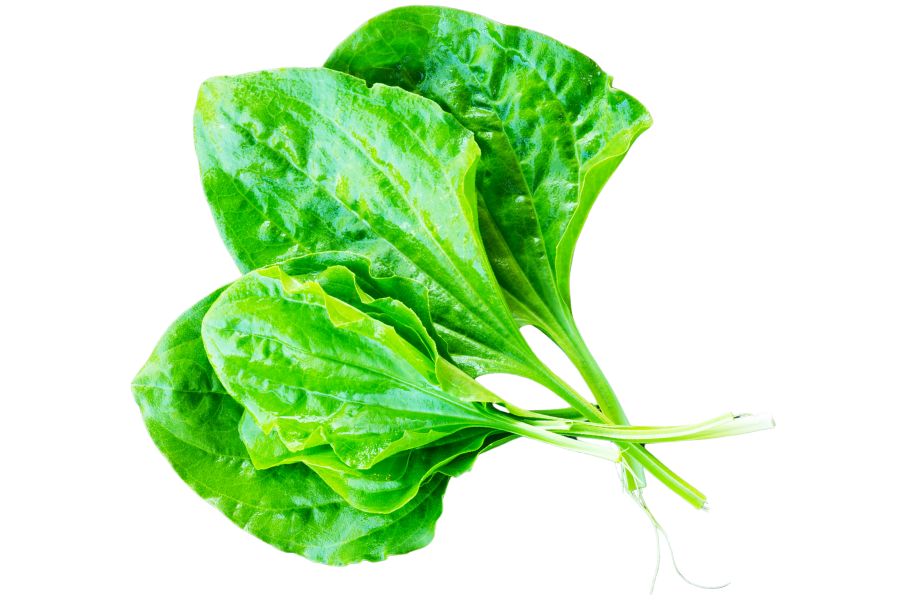Across Alabama, edible plants are growing in more places than most people realize. Mulberries ripen fast and sweet in early summer, while dandelion greens stay tender through spring and fall. A well-timed foraging trip can turn up ingredients that never see grocery store shelves.
The leaves of lamb’s quarters can rival spinach in flavor, and sumac berries can add a citrusy twist to just about anything. Even goldenrod, often dismissed as a weed, holds edible potential when handled correctly. Knowing which parts to pick and when to pick them makes all the difference.
These plants are only a small part of what’s out there. Alabama’s seasons bring wave after wave of edible species, some familiar, many not. With the right knowledge, you can gather more than expected and leave with a mix of wild flavors worth exploring.
What We Cover In This Article:
- The Edible Plants Found in the State
- Toxic Plants That Look Like Edible Plants
- How to Get the Best Results Foraging
- Where to Find Forageables in the State
- Peak Foraging Seasons
- The extensive local experience and understanding of our team
- Input from multiple local foragers and foraging groups
- The accessibility of the various locations
- Safety and potential hazards when collecting
- Private and public locations
- A desire to include locations for both experienced foragers and those who are just starting out
Using these weights we think we’ve put together the best list out there for just about any forager to be successful!
A Quick Reminder
Before we get into the specifics about where and how to find these plants and mushrooms, we want to be clear that before ingesting any wild plant or mushroom, it should be identified with 100% certainty as edible by someone qualified and experienced in mushroom and plant identification, such as a professional mycologist or an expert forager. Misidentification can lead to serious illness or death.
All plants and mushrooms have the potential to cause severe adverse reactions in certain individuals, even death. If you are consuming wild foragables, it is crucial to cook them thoroughly and properly and only eat a small portion to test for personal tolerance. Some people may have allergies or sensitivities to specific mushrooms and plants, even if they are considered safe for others.
The information provided in this article is for general informational and educational purposes only. Foraging involves inherent risks.
The Edible Plants Found in the State
Wild plants found across the state can add fresh, seasonal ingredients to your meals:
Bramble (Rubus fruticosus)
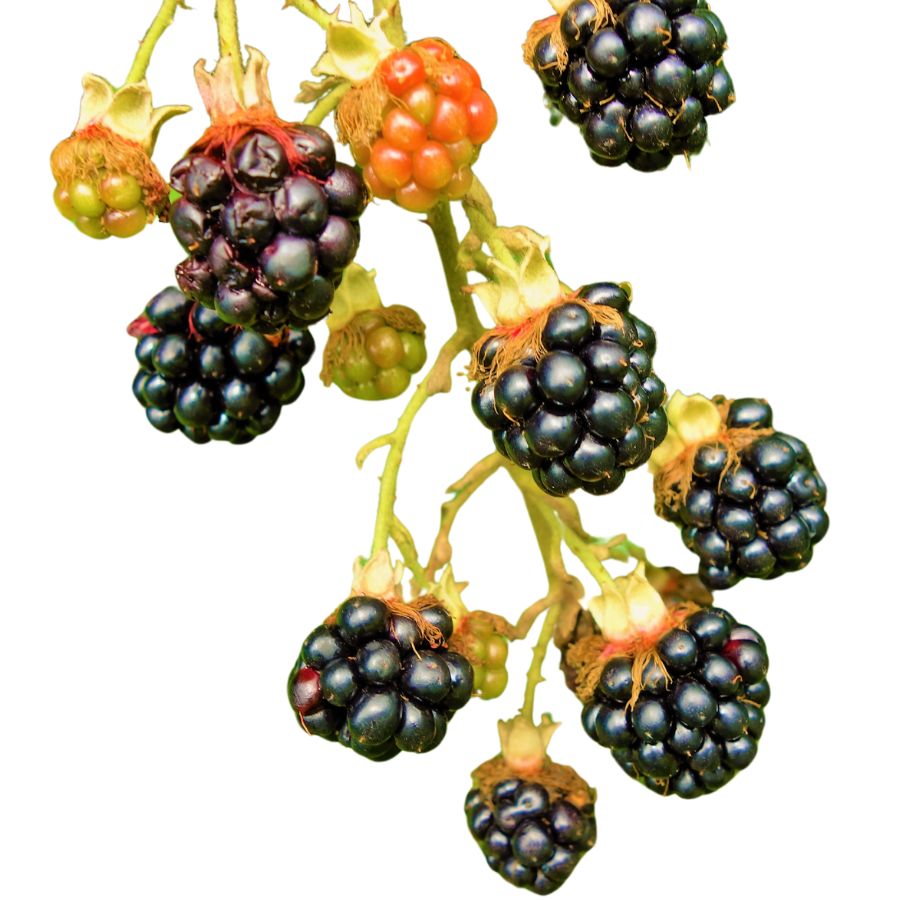
The fruit of brambles grows in clusters of small, shiny drupelets that form a rounded or slightly conical shape, usually deep black when ripe. They have a juicy, sweet-tart flavor and a seedy texture that’s familiar in pies and jams.
You can also eat the young shoots peeled raw or lightly cooked, though the rest of the stem is covered in thorns and not edible. Bramble leaves are technically edible, but they’re very astringent and more commonly steeped for tea than eaten.
Avoid mistaking black nightshade berries for brambles; nightshade fruits grow singly, have smooth skin, and lack the segmented drupelet structure. While brambles grow on thorny, arching canes, nightshade plants tend to be smaller, herbaceous, and thornless.
Brambles are commonly turned into jam, syrup, or wine, but they’re also good fresh in salads or mashed into sauces. If you’re harvesting, beware the bramble thorns, which can break the skin and cause irritation if you aren’t careful.
Blueberry (Vaccinium spp.)
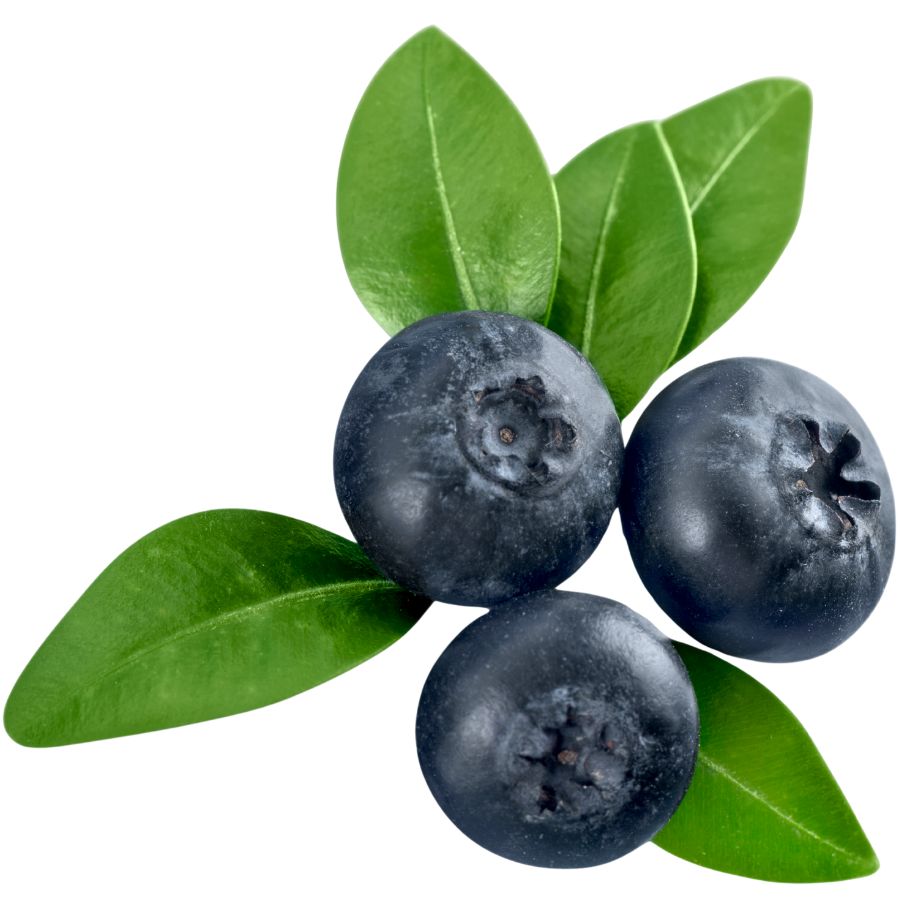
Blueberry, sometimes called highbush or lowbush blueberry depending on the type, grows as a shrub with smooth-edged, oval leaves and clusters of small white or pinkish bell-shaped flowers. The berries start green and ripen to a deep blue with a dusty-looking skin that easily rubs off.
A few lookalikes can confuse foragers, like the berries of Virginia creeper or pokeweed, but the differences are clear when you know what to check. True blueberries grow on woody shrubs and have a five-pointed crown on the bottom of each berry, while dangerous lookalikes often grow on vines or have no crown at all.
Blueberries have a sweet, sometimes tangy flavor and a juicy texture that makes them great for fresh eating. You can also bake them into pies, simmer them into jams, or dry them for snacks.
Only the ripe berries are eaten, while the leaves and stems are usually left alone.
Interestingly, blueberries is that they contain natural pigments that can turn recipes and even your fingers a deep purple when handled.
American Persimmon (Diospyros virginiana)
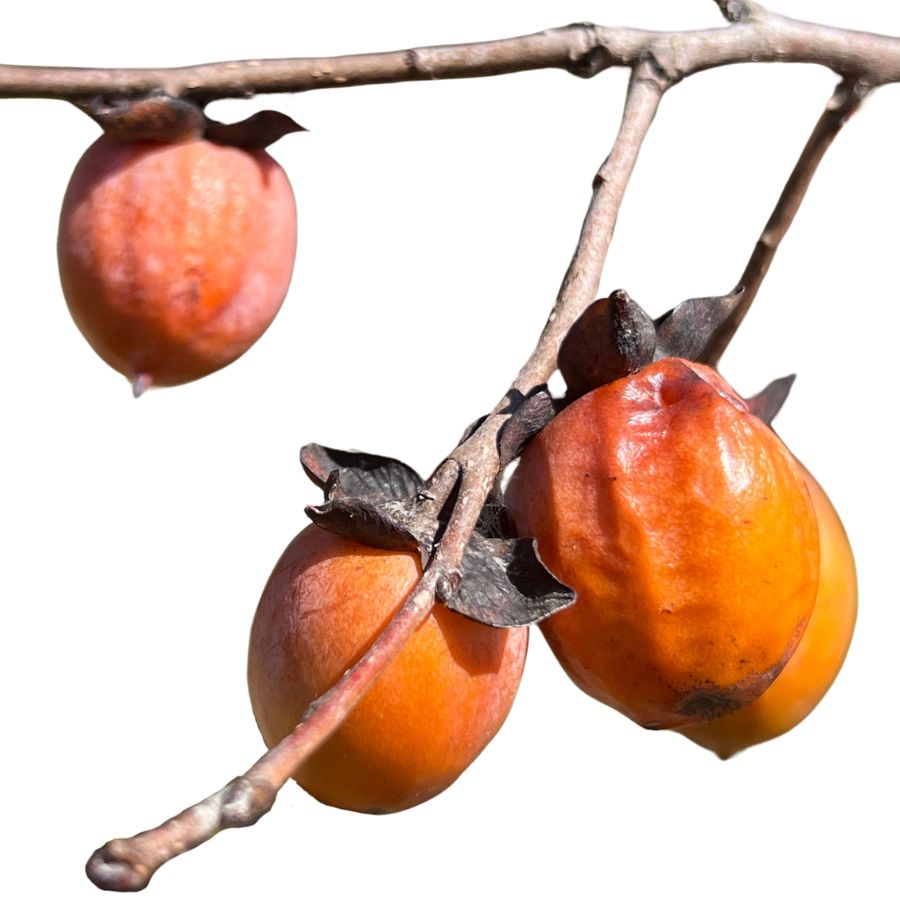
Persimmon, sometimes called American persimmon or common persimmon, grows as a small tree with rough, blocky bark and oval-shaped leaves. The fruit looks like a small, flattened tomato and turns a deep orange or reddish color when ripe.
If you bite into an unripe persimmon, you will quickly notice an extremely astringent, mouth-drying effect. A ripe persimmon, on the other hand, tastes sweet, rich, and custard-like, with a soft and jelly-like texture inside.
You can eat persimmons fresh once they are fully ripe, or you can cook them down into puddings, jams, and baked goods. Some people also mash and freeze the pulp to use later for pies, breads, and sauces.
Wild persimmons can sometimes be confused with black nightshade berries, but nightshade fruits are much smaller, grow in clusters, and stay dark purple or black. Only the ripe fruit of the persimmon tree should be eaten; the seeds and the unripe fruit are not edible.
Elderberry (Sambucus nigra)
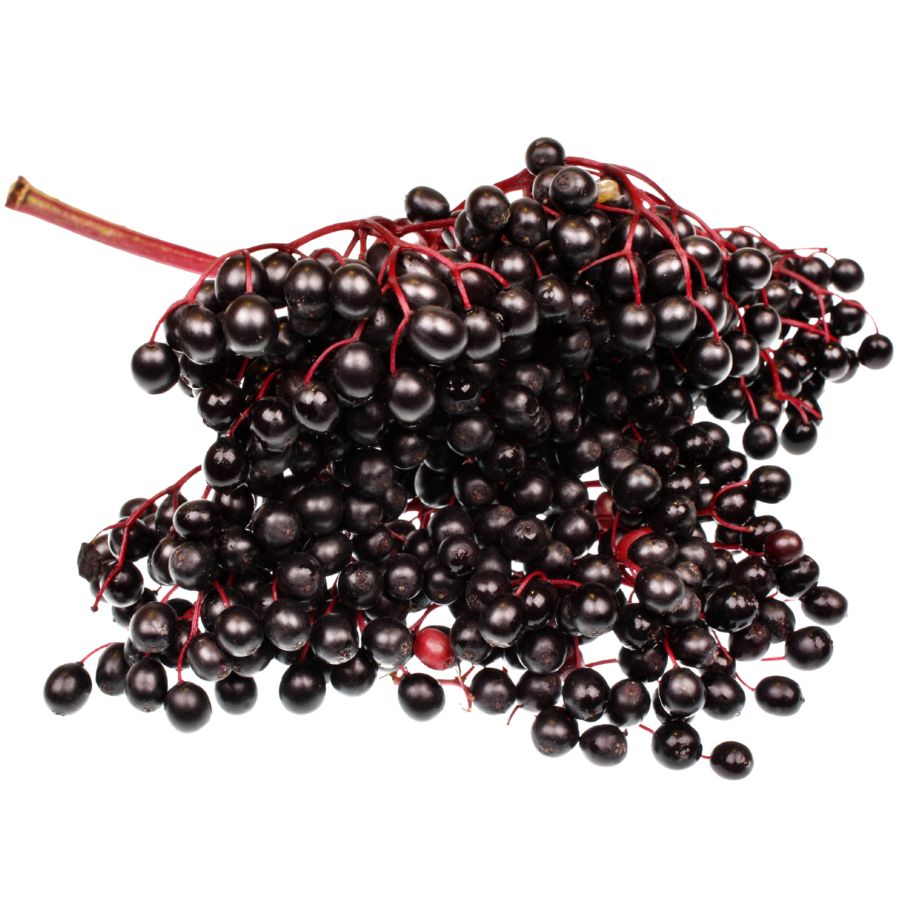
Elderberry is often called American elder, common elder, or sweet elder. It grows as a large, shrubby plant with clusters of tiny white flowers that eventually turn into deep purple to black berries.
You can recognize elderberry by its compound leaves with five to eleven serrated leaflets and its flat-topped flower clusters. One important thing to watch out for is its toxic lookalikes, like pokeweed, which has very different smooth-edged leaves and reddish stems.
The ripe berries have a tart, almost earthy flavor and a soft texture when cooked. People usually cook elderberries into syrups, jams, pies, or wine because eating raw berries can cause nausea.
Only the ripe, cooked berries and flowers are edible, while the leaves, stems, and unripe berries are toxic. Always take care to strip the berries cleanly from their stems before using them, as even small bits of stem can cause problems.
Mulberry (Morus rubra)
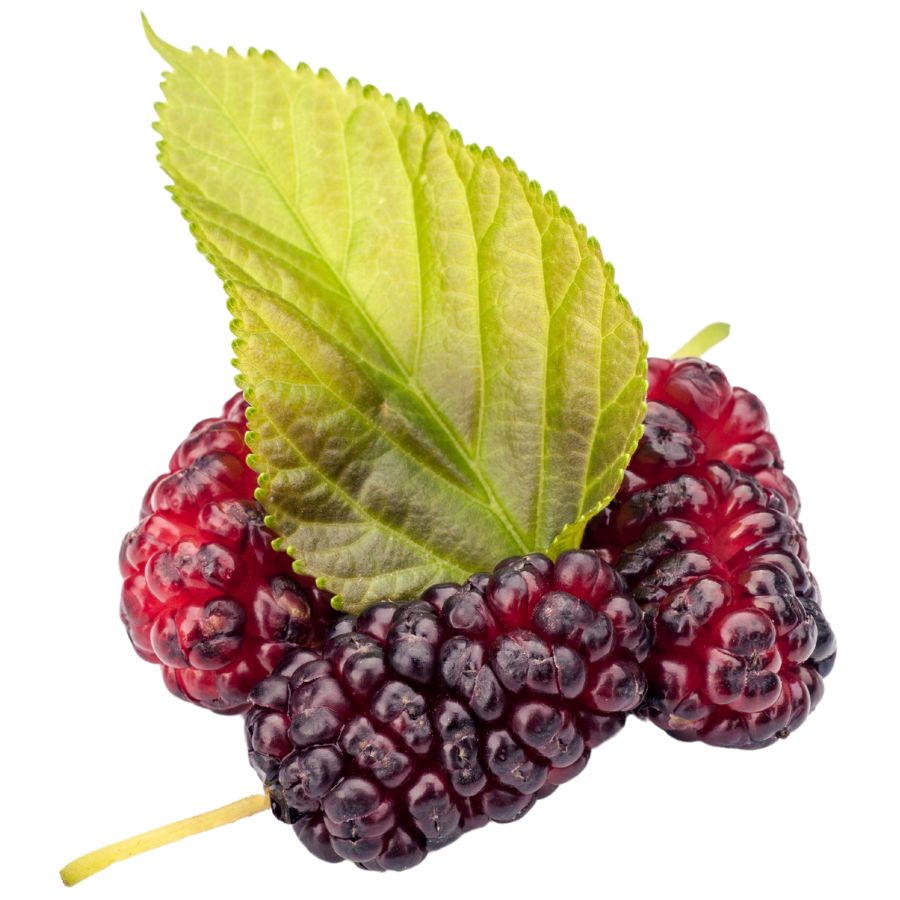
Sweet, juicy, and often overlooked, mulberries are one of the easiest wild berries to recognize. Known by names like white mulberry and red mulberry, these trees produce small, blackberry-like fruits that range from pale pink to deep purple.
The berries have a soft, almost melting texture with a mild tartness behind the sugar. You can eat them fresh by the handful, bake them into pies, or simmer them down into homemade jams and syrups.
While the fruits are safe and delicious when ripe, you should avoid eating the unripe berries or any part of the tree’s sap, which can cause stomach upset. It is also worth knowing that mulberries are delicate and bruise easily when picked, so handle them gently.
Red osier dogwood and some honeysuckles can produce berries that look similar from a distance, but true mulberries grow singly or in loose clusters along the branches and have a distinctive leaf shape that sets them apart. Always double-check the leaf texture and berry arrangement before eating any wild fruits.
American Beautyberry (Callicarpa americana)
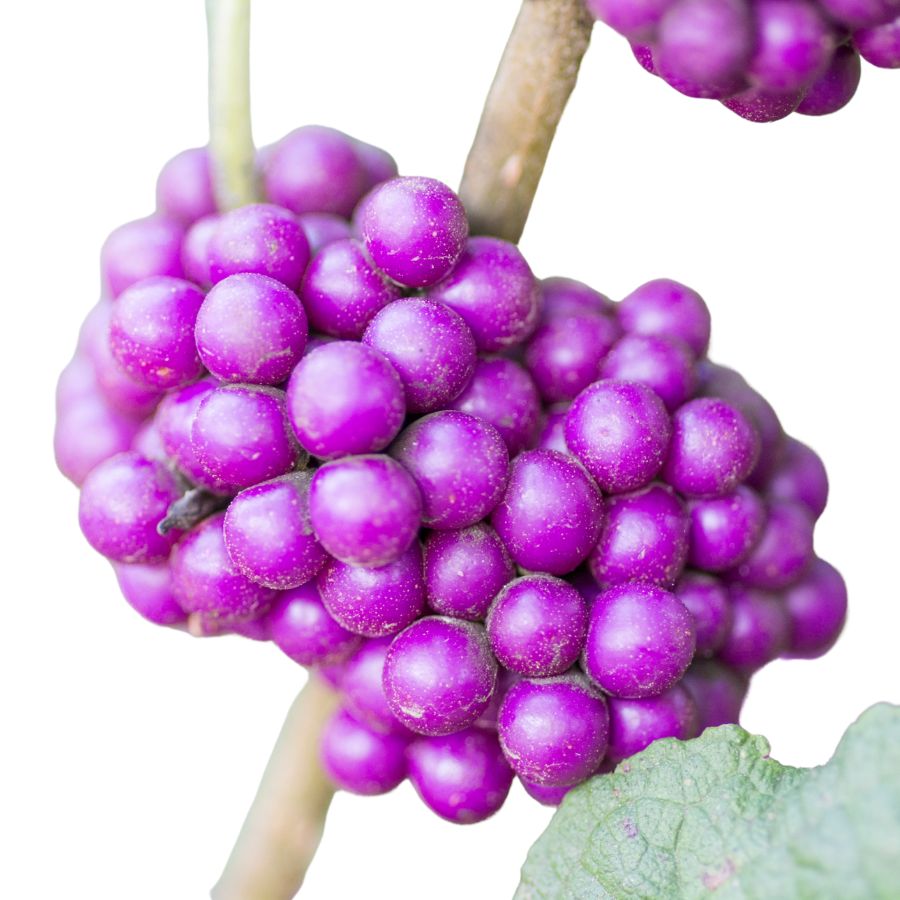
American beautyberry, sometimes called French mulberry or sourbush, is highly easily recognizable thanks to its bright clusters of purple berries wrapped tightly around its stems. The plant itself has arching branches and broad, serrated leaves that give off a slight spicy scent when crushed.
The berries are edible and have a mild, slightly sweet flavor with a soft, juicy texture that some people find a little gritty. Only the ripe purple berries should be eaten, as the leaves and unripe berries are not considered edible.
One of the easiest ways to enjoy beautyberries is by making jelly, where the fruit’s subtle taste really shines through. Some people also simmer the berries into syrups or add them to baked goods, although the flavor can be too delicate to stand out without a little help from sugar or lemon.
Beautyberries are sometimes confused with pokeweed, but pokeweed’s berries are a darker purple and grow on red stems in drooping clusters rather than tight whorls. Always double-check the plant’s structure and berry arrangement so you can be sure you are harvesting true American beautyberry.
Pine (Pinus spp.)
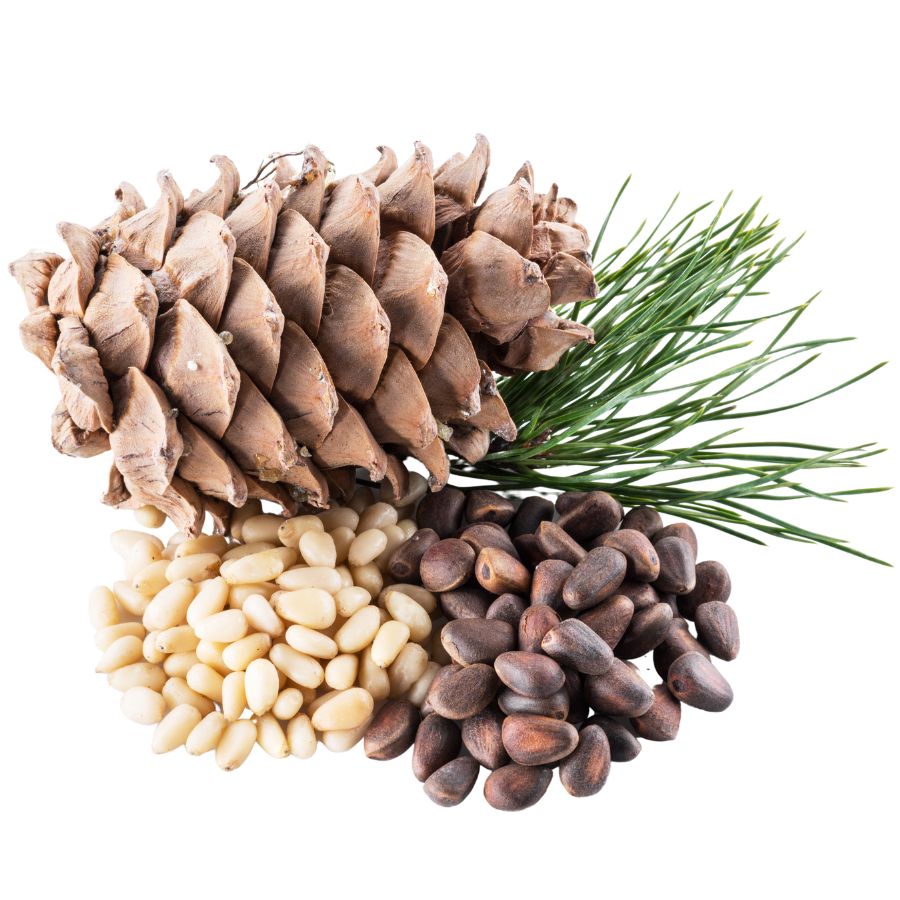
Pine trees offer several edible parts, including the fresh needles, which are used to make tea with a piney, slightly sour flavor. Their bundles of long, slender needles make them easy to separate from toxic lookalikes like yew, which has flat, single needles.
The seeds—pine nuts—are tucked away between the scales of mature cones and are highly nutritious. They’re often toasted to bring out their rich, oily flavor and are commonly added to trail mixes and pasta dishes.
You can scrape the soft white layer of inner bark and dry it into flour, though it’s mostly a fallback food. This layer is chewy when raw and works best when baked or roasted.
Not all pines are safe to eat, and some species contain compounds that can upset your stomach. When in doubt, Eastern White Pine is one of the most widely accepted edible types.
Plantain (Plantago major)
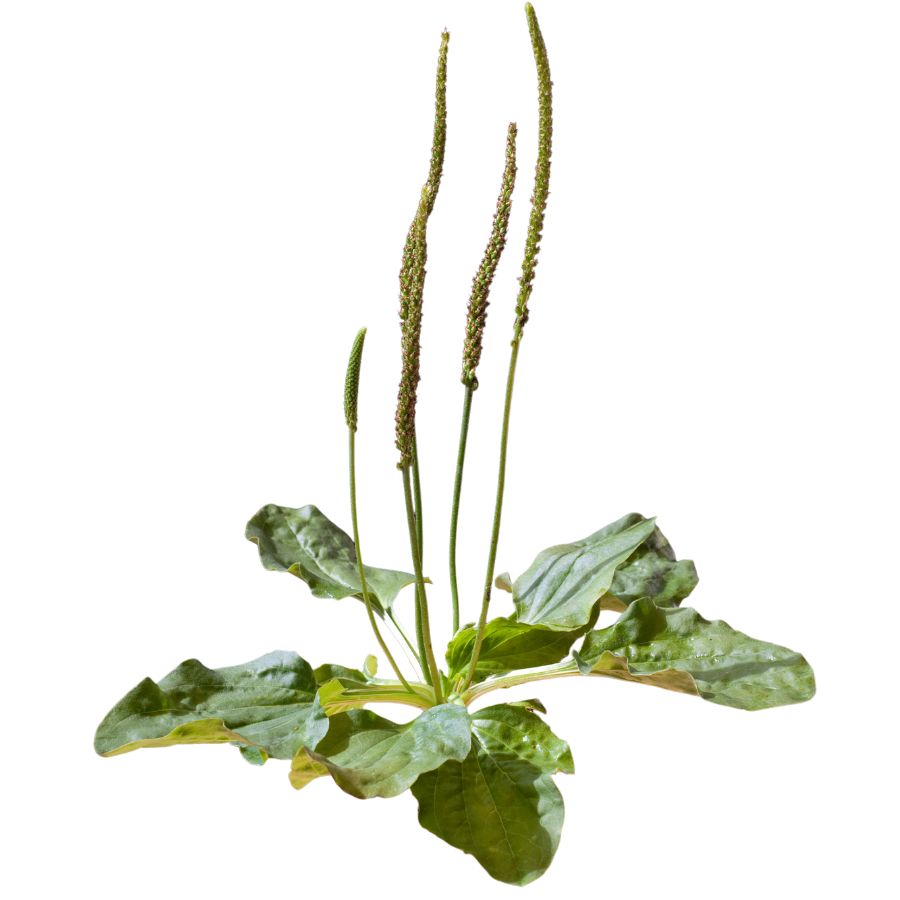
Plantain, also called common plantain or narrowleaf plantain depending on the type, is a low-growing plant with broad or lance-shaped leaves and tall, slender flower spikes. The leaves grow in a rosette close to the ground, and the thick veins running through them are one of the easiest ways to tell it apart from other plants.
You can mainly eat the young leaves and the seeds of the plants. Older leaves can become tough and stringy, so it is best to pick the smaller, tender ones when you want to eat them.
Plantain leaves have a slightly bitter, earthy taste and a chewy texture, especially when eaten raw. Many people like to add them to salads, soups, or stews, or lightly steam them to soften the flavor.
Always make sure you have a true plantain before eating because some similar-looking yard plants are not palatable and can upset your stomach. Look for the strong parallel veins and the tough, fibrous stems to help confirm your find.
Dandelion (Taraxacum officinale)
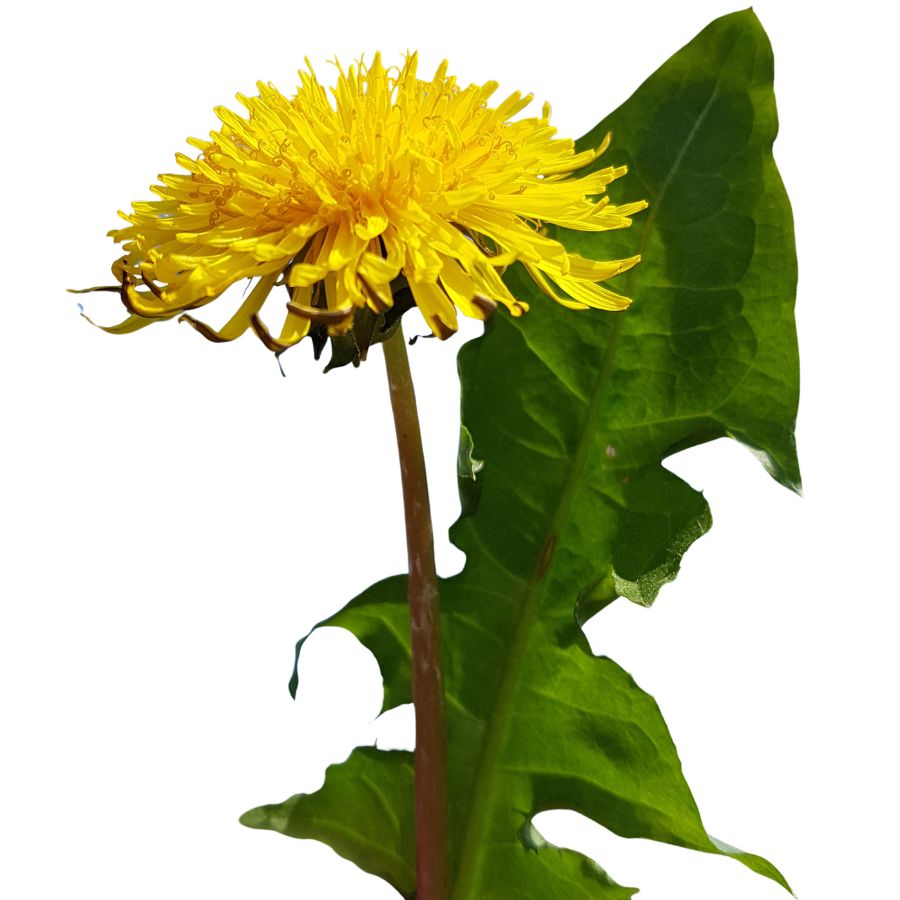
Bright yellow flowers and jagged, deeply toothed leaves make dandelions easy to spot in open fields, lawns, and roadsides. You might also hear them called lion’s tooth, blowball, or puffball once the flowers turn into round, white seed heads.
Every part of the dandelion is edible, but you will want to avoid harvesting from places treated with pesticides or roadside areas with heavy car traffic. Besides being a food source, dandelions have been used traditionally for simple herbal remedies and natural dye projects.
Young dandelion leaves have a slightly bitter, peppery flavor that works well in salads or sautés, and the flowers can be fried into fritters or brewed into tea. Some people even roast the roots to make a coffee substitute with a rich, earthy taste.
One thing to watch out for is cat’s ear, a common lookalike with hairy leaves and branching flower stems instead of a single, hollow one. To make sure you have a true dandelion, check for a smooth, hairless stem that oozes a milky sap when broken.
Lamb’s Quarters (Chenopodium album)
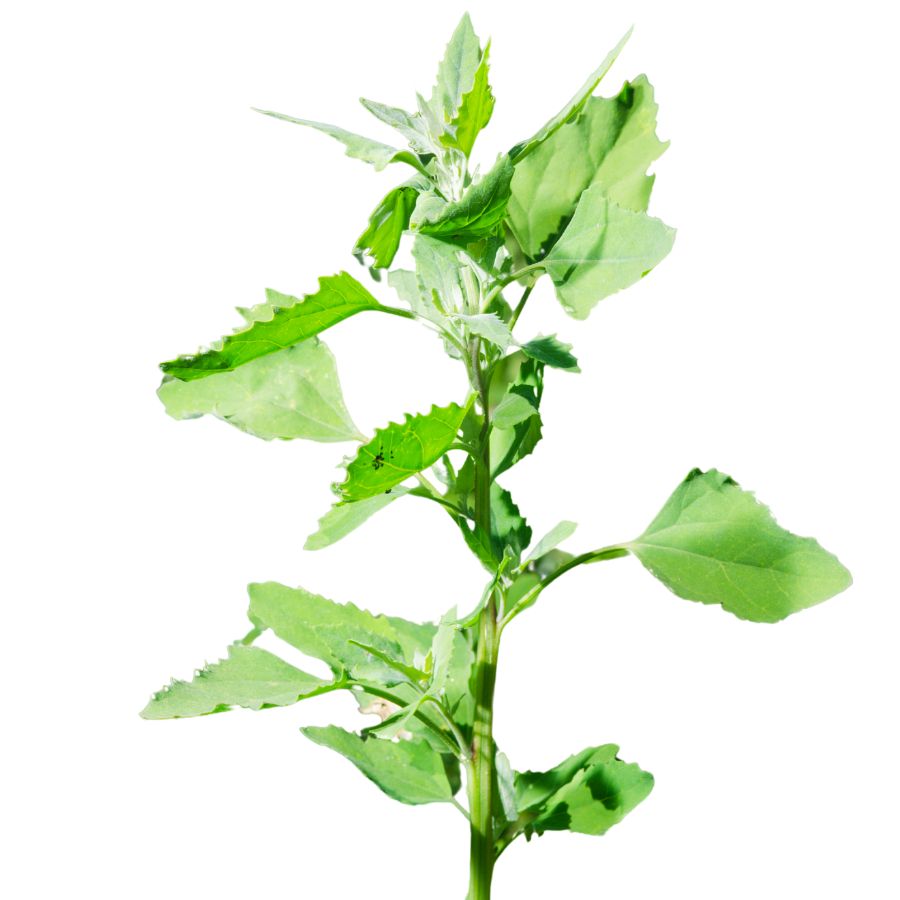
Lamb’s quarters, also called wild spinach and pigweed, has soft green leaves that often look dusted with a white, powdery coating. The leaves are shaped a little like goose feet, with slightly jagged edges and a smooth underside that feels almost velvety when you touch it.
A few plants can be confused with lamb’s quarters, like some types of nightshade, but true lamb’s quarters never have berries and its leaves are usually coated in that distinctive white bloom. Always check that the stems are grooved and not round and smooth like the poisonous lookalikes.
When you taste lamb’s quarters, you will notice it has a mild, slightly nutty flavor that gets richer when cooked. The young leaves, tender stems, and even the seeds are all edible, but you should avoid eating the older stems because they become tough and stringy.
People often sauté lamb’s quarters like spinach, blend it into smoothies, or dry the leaves for later use in soups and stews. It is also rich in oxalates, so you will want to cook it before eating large amounts to avoid any problems.
American Plum (Prunus americana)
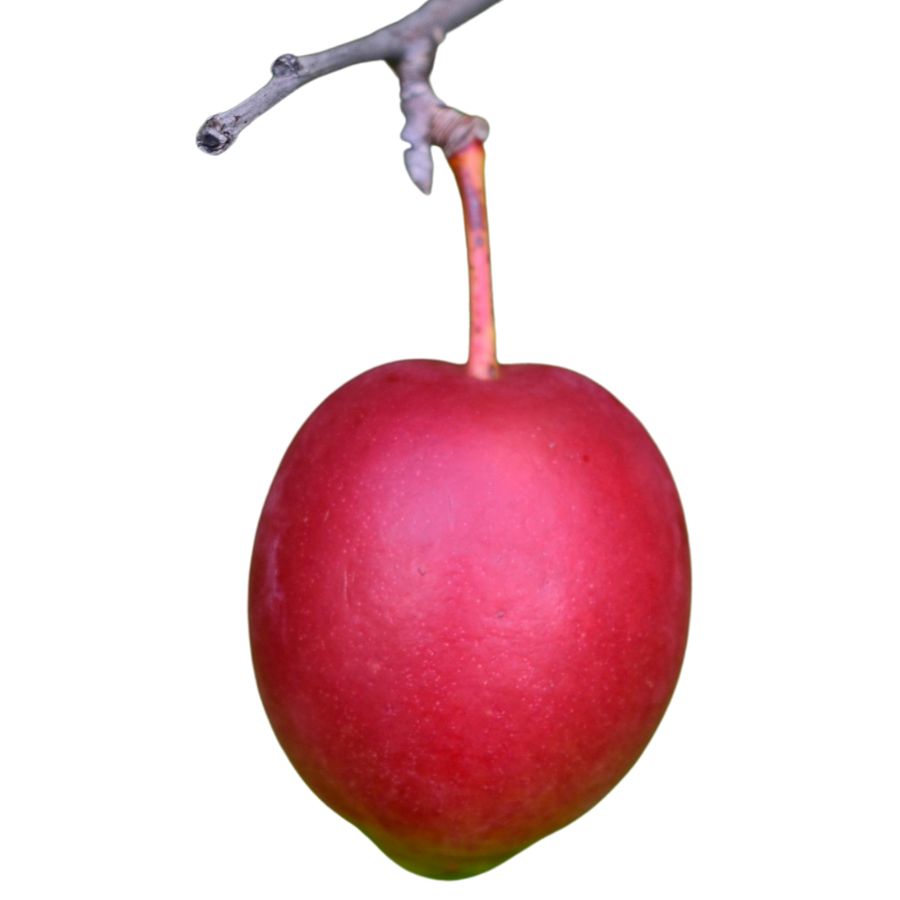
American plum, also called wild plum or river plum, produces small round fruits that range in color from yellow to deep red when ripe. The skin is slightly tart, but the flesh is soft, juicy, and sweet with a hint of spice.
You can eat the fruit raw or turn it into jellies, sauces, or wines—its natural pectin makes it ideal for preserves. Just avoid the seeds and leaves, which contain compounds that can release cyanide when crushed or chewed.
Its bark is rough and dark, and the branches often have short, sharp spines. The plant’s simple oval leaves and white spring flowers help distinguish it from less edible lookalikes like black cherry, which has longer, narrower leaves with a more bitter fruit.
If the fruit has a strong bitter almond smell when crushed, steer clear—it might be a different species altogether. American plum fruit clusters tend to be smaller and more tightly packed than those of cultivated varieties.
Milkweed (Asclepias syriaca)
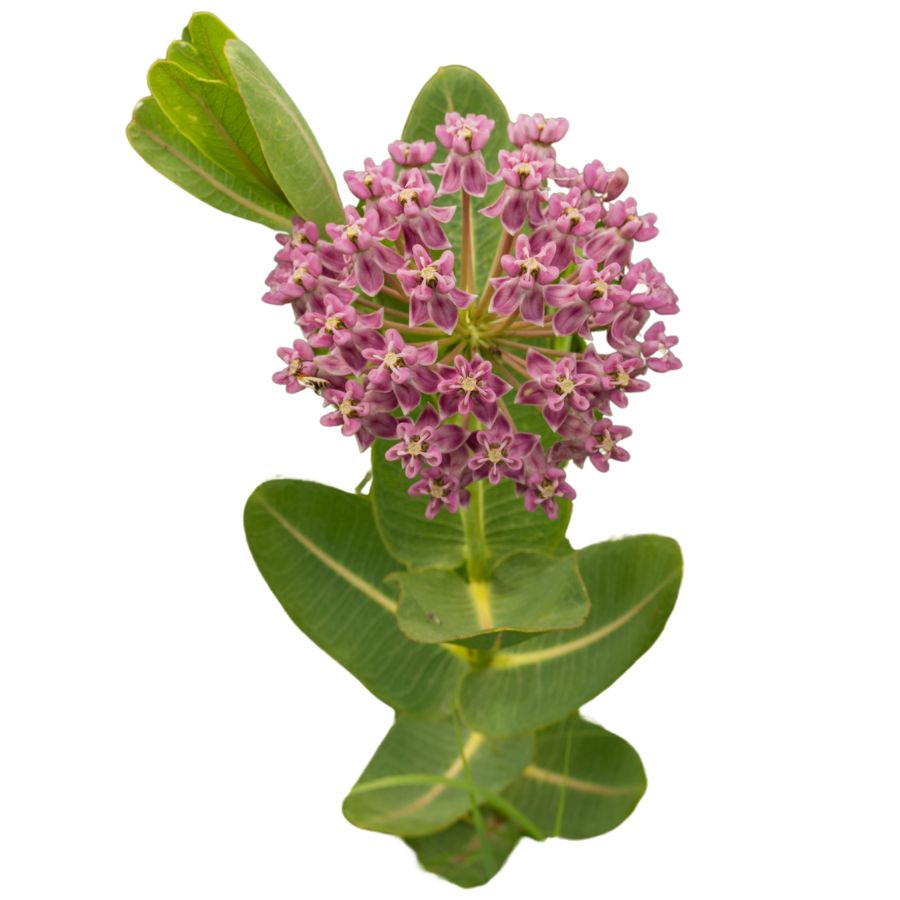
Known for its thick stems, broad leaves, and clusters of pinkish-purple flowers, common milkweed is sometimes called silkweed or butterfly flower. When you snap a stem or leaf, it releases a milky sap that helps you tell it apart from other plants that can be harmful.
If you want to try it in the kitchen, focus on gathering the young shoots, the tightly closed flower buds, and the small, immature pods. These parts have a mild, slightly sweet flavor when cooked, and their soft texture makes them a good addition to soups, sautés, and fritters.
Getting it ready to eat takes a little care, since boiling the plant parts in several changes of water helps remove bitterness and unwanted compounds. Some people also like to steam the buds or fry the pods lightly to bring out their best taste.
Although monarch caterpillars rely on this plant for survival, it has a long history of being used by people as well. Watch out for lookalikes like dogbane, though, since they share the same milky sap but are dangerously toxic if eaten.
Wood Sorrel (Oxalis stricta)
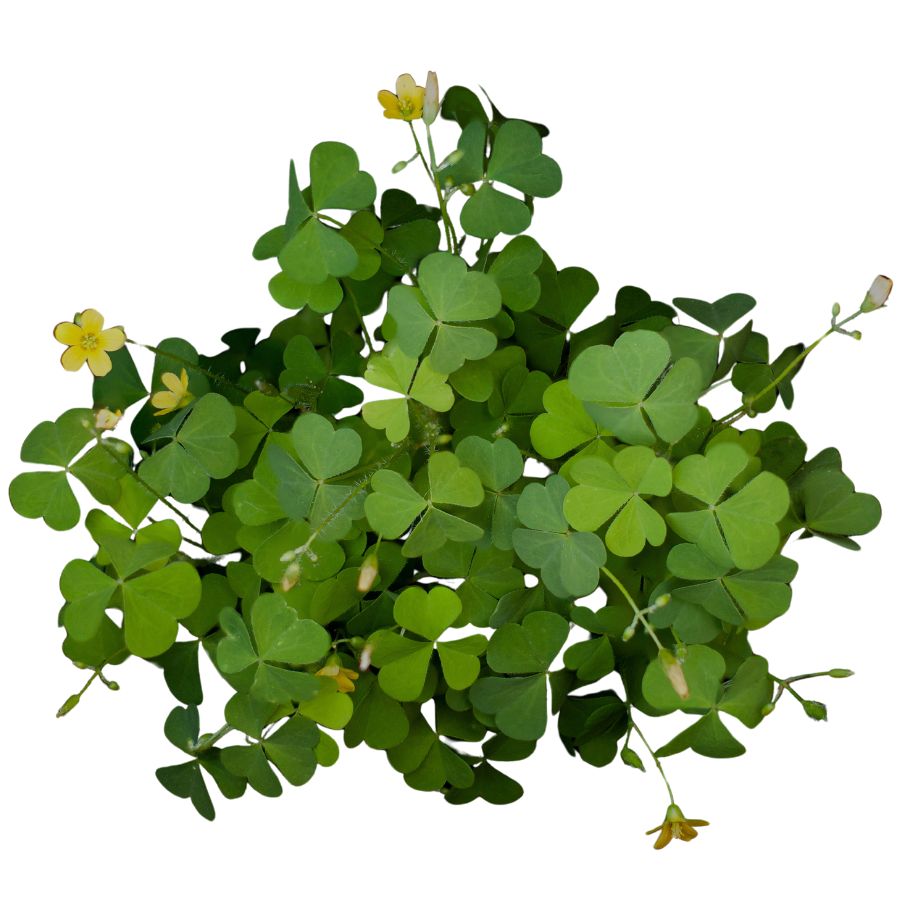
Wood sorrel has clover-like leaves and small yellow flowers. Each leaflet is heart-shaped, and the plant often folds up when touched or in low light.
The leaves, flowers, and seed pods are all safe to eat and have a tart, lemony flavor thanks to the oxalic acid they contain. You can toss them into salads, use them as a garnish, or nibble on them raw for a refreshing sour bite.
Be careful not to confuse it with clover, which has rounder leaves and lacks the same sharp tang when tasted. Large amounts of wood sorrel aren’t recommended if you have kidney issues, since oxalic acid can be hard on the kidneys over time.
The texture of the leaves is soft and delicate, making them a nice contrast in dishes with heavier greens. Even the seed pods have a bit of crunch and a pleasant tang if you catch them before they dry out.
Curly Dock (Rumex crispus)
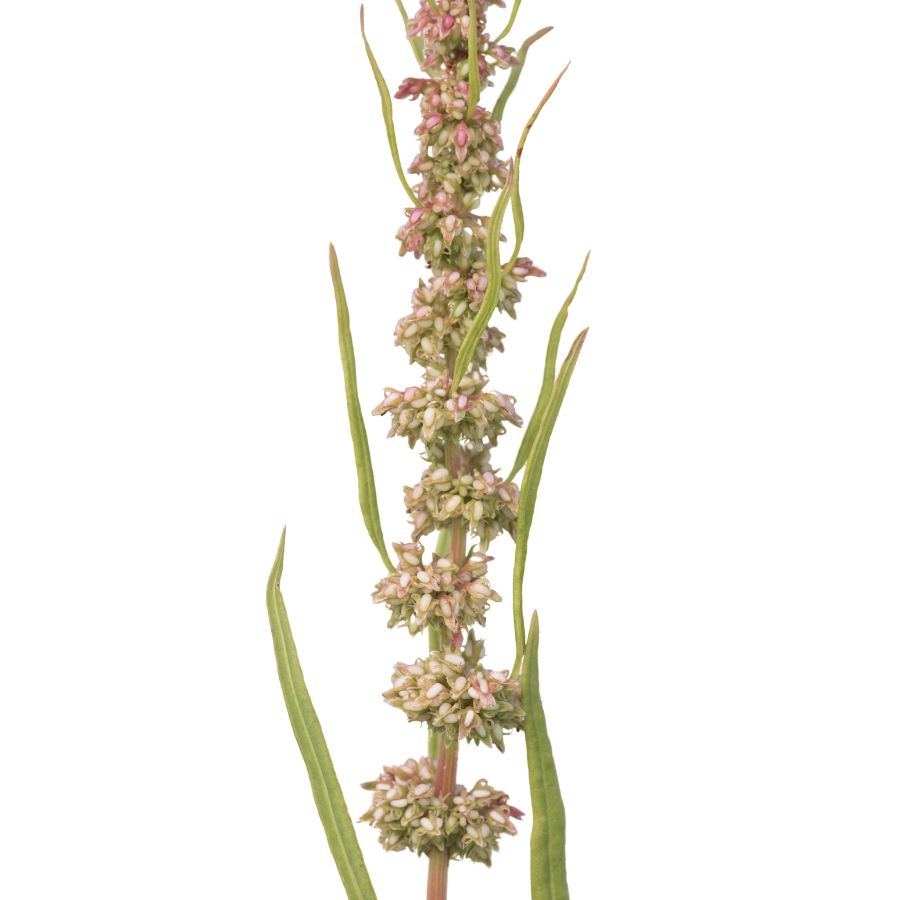
Curly dock, sometimes called yellow dock, is easy to spot once you know what to look for. It has long, wavy-edged leaves that form a rosette at the base, with tall stalks that eventually turn rusty brown as seeds mature.
The young leaves are edible and often cooked to mellow out their sharp, lemony taste, which can be too strong when eaten raw. You can also dry and powder the seeds to use as a flour supplement, although they are tiny and take some effort to prepare.
Curly dock has some lookalikes, like other types of dock and sorrel, but its heavily crinkled leaf edges and thick taproot help it stand out. Be careful not to confuse it with plants like wild rhubarb, which can have toxic parts if misidentified.
Besides being edible, curly dock has a history of being used in homemade remedies for skin irritation. The roots are not eaten raw because they are tough and contain compounds that can upset your stomach if you are not careful.
Goldenrod (Solidago canadensis)
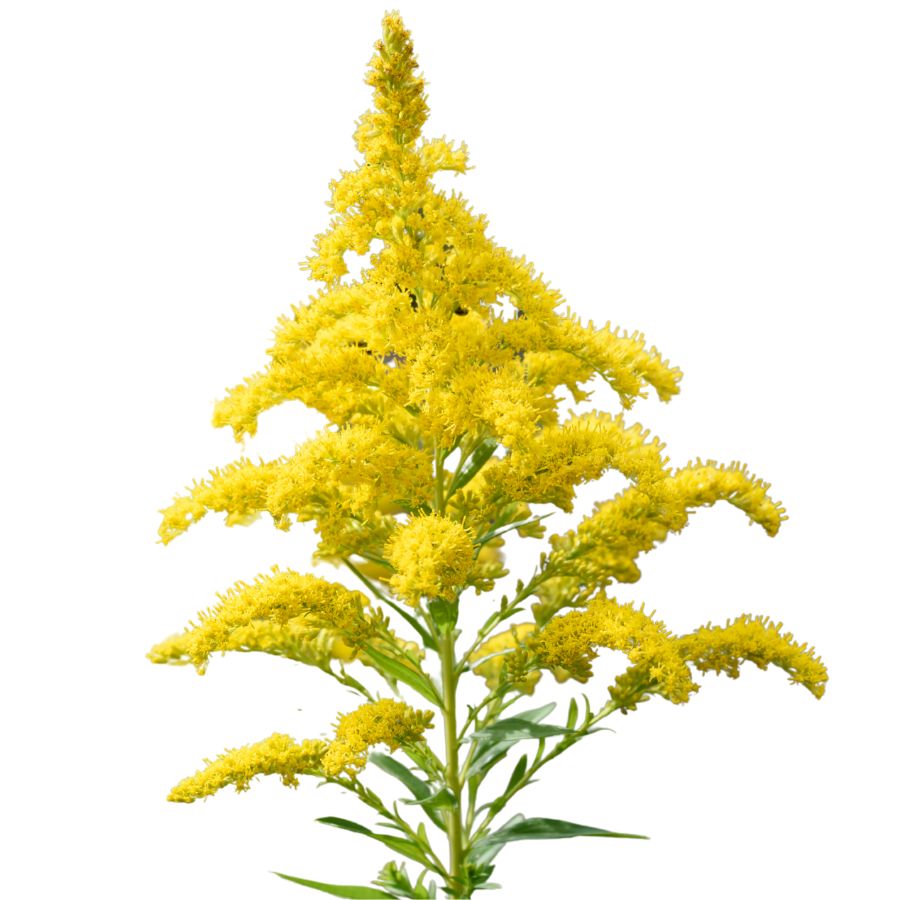
Goldenrod has tall, unbranched stems topped with golden flower sprays that you can dry or steep into tea. The taste is bold and slightly astringent, often balanced with lemon or mint in homemade brews.
Don’t mistake it for ragweed, which causes allergies and has inconspicuous green flowers instead. Goldenrod’s edible parts include the flowers and younger leaves, though the leaves are better when fresh.
Try candying the blossoms or using them as a garnish—they hold their color and shape surprisingly well. The flowers can be sticky with pollen, so rinse them gently if you’re using them fresh.
Goldenrod can cause reactions in people sensitive to other members of the aster family, so test it carefully if you’re unsure. Some people also notice a mild laxative effect if they consume too much at once.
Sumac (Rhus spp.)
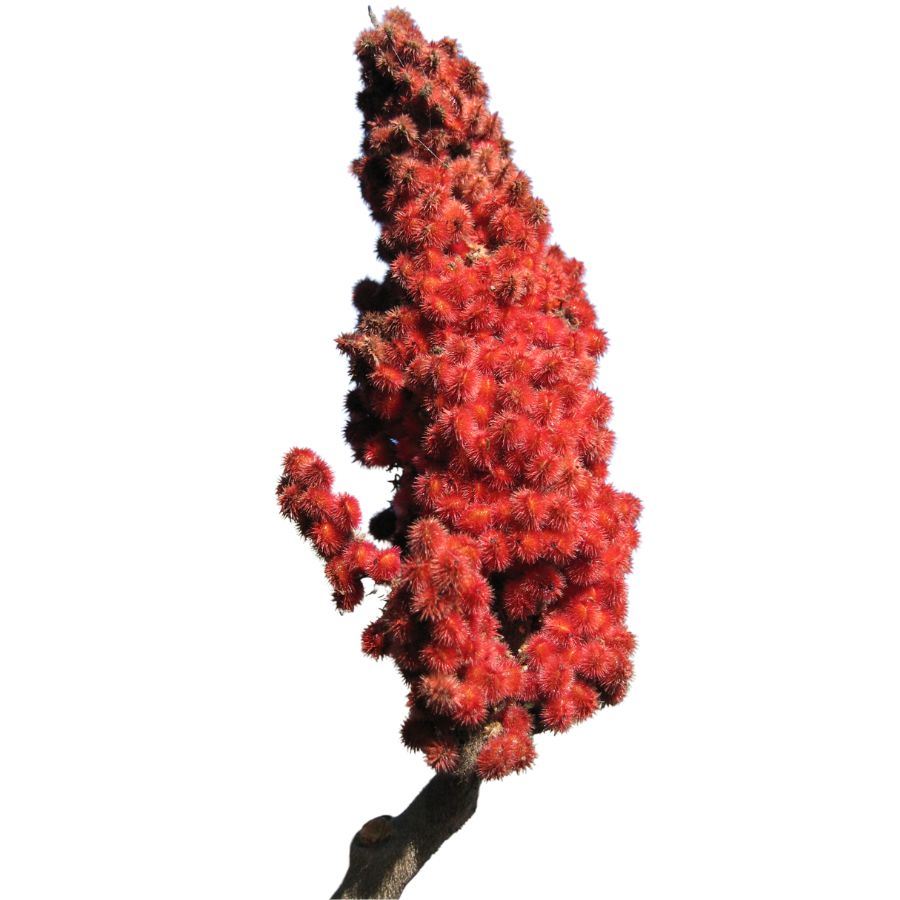
The edible part of staghorn sumac is the hairy, red fruit cluster that forms a cone shape at the tip of its branches. These clusters are packed with malic acid, giving them a tart flavor that’s perfect for making infused drinks.
Some people confuse it with poison sumac, but poison sumac has drooping white berries and lacks the fuzzy stems of staghorn sumac. That visual difference is critical when deciding what’s safe to forage.
After soaking the berry clusters in water, strain the result through a cloth or coffee filter to remove the irritating surface hairs. The liquid has a lemony bite that pairs well with honey or mint.
You can also dry the clusters and grind them into a reddish powder used like sumac spice in Middle Eastern dishes. Stick to the fruit only—none of the other parts are edible.
Pawpaw (Asimina triloba)
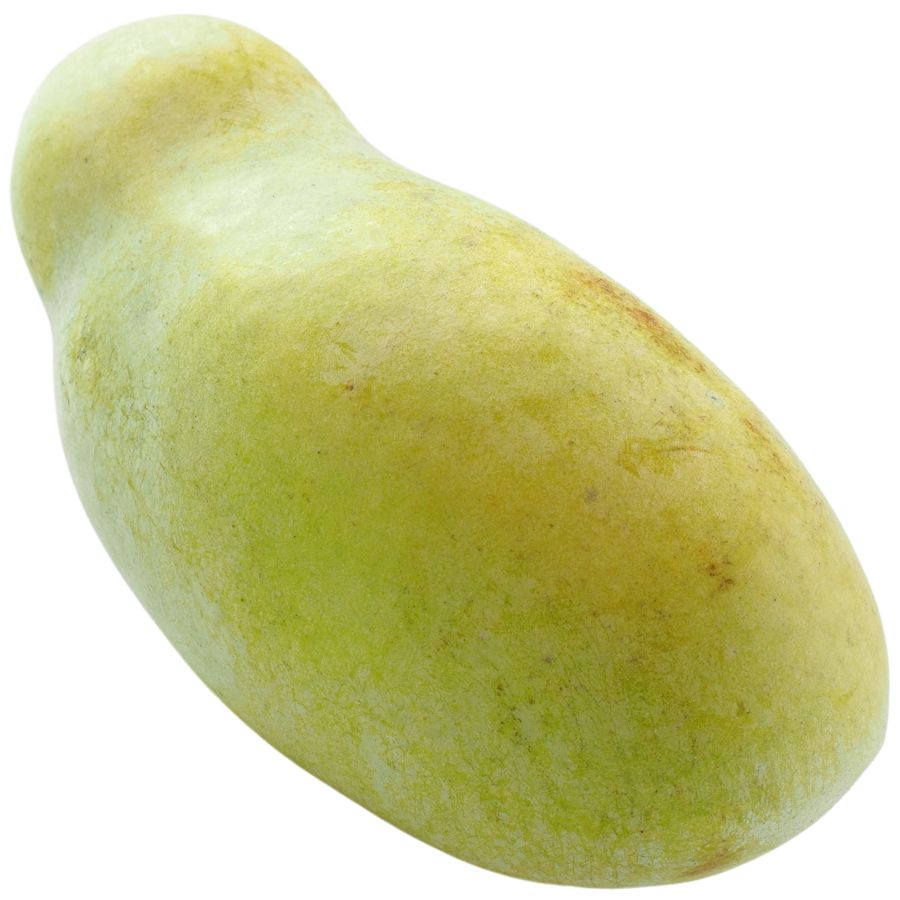
The pawpaw grows fruits that are green and shaped a little like small mangoes. Inside, the soft yellow flesh tastes like a blend of banana, mango, and melon, with a custard-like texture that melts in your mouth.
If you are comparing it to similar plants, keep in mind that young pawpaw trees can look a little like young magnolias because of their large leaves. True pawpaws grow fruits with large brown seeds tucked inside, while magnolias do not produce anything that looks or tastes similar.
You can eat the flesh straight out of the skin with a spoon, or mash it into puddings, smoothies, and even homemade ice cream. Some people also like to freeze it into cubes for later, although it does tend to brown quickly once exposed to air.
Stick to eating the soft inner flesh. Make sure not to ingest the skin and seeds of the fruit because they contain compounds that can upset your stomach.
This fruit is that it was a favorite snack of Native Americans and early explorers long before it started showing up in backyard gardens.
Watercress (Nasturtium officinale)
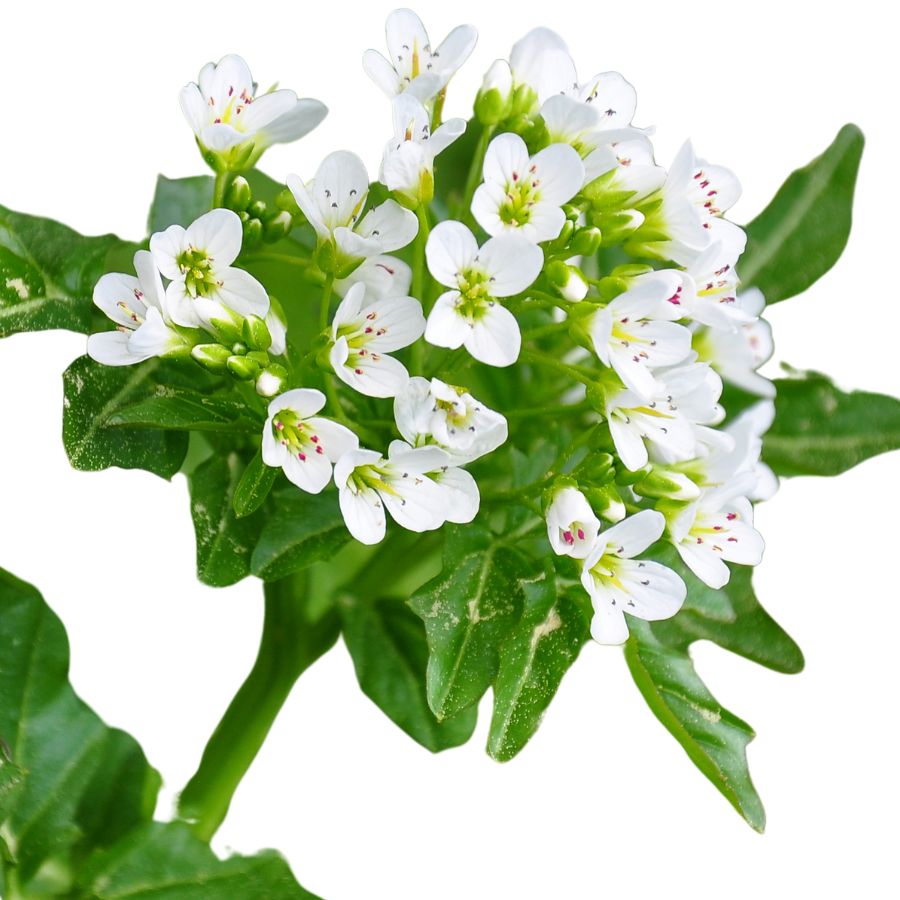
Watercress, also known as yellowcress or garden cress, is an aquatic plant with small, rounded green leaves and hollow stems that often float along the water’s surface. It usually grows in dense mats, and the bright green color is one of the easiest ways to spot it in clear, shallow streams and ponds.
Besides being a popular edible green, watercress has been traditionally used in herbal remedies, especially for boosting digestion and respiratory health.
The leaves and stems are edible, offering a crisp texture and a peppery, slightly spicy taste that can remind you of arugula. People often enjoy it raw in salads, blended into soups, or lightly wilted into stir-fries for a fresh bite.
Stick to eating the leaves and stems, and avoid any parts that look yellowed or slimy, since healthy watercress should always look vibrant and clean.
Watercress has a few lookalikes like lesser celandine or young wild mustard, but true watercress has a distinct sharp flavor and tends to grow only in moving, clean water. Always double-check your identification, because gathering from stagnant or contaminated water sources can expose you to harmful bacteria or parasites.
Bull Thistle (Cirsium vulgare)

Bull thistle has long spines covering its leaves and stem, but the inner stem, flower stalks, and roots are edible when properly handled. The root has a flavor similar to Jerusalem artichoke and turns soft when boiled or roasted.
You can steam or boil the peeled stem to get a mild, artichoke-like taste with a fibrous bite. Raw, the stem is tougher but still palatable when young and peeled thoroughly.
Watch out for thistles with smooth or hairless leaves—these may be other species that don’t offer the same edible value. Bull thistle has deeply lobed, hairy leaves with sharp tips, helping you separate it from potentially less useful relatives.
Avoid the leaves unless you’re just after a bitter nibble, and never attempt to chew the spiny parts without removing all barbs. Flower heads can be used like small artichokes, though the yield is minimal compared to the effort.
Burdock (Arctium minus)
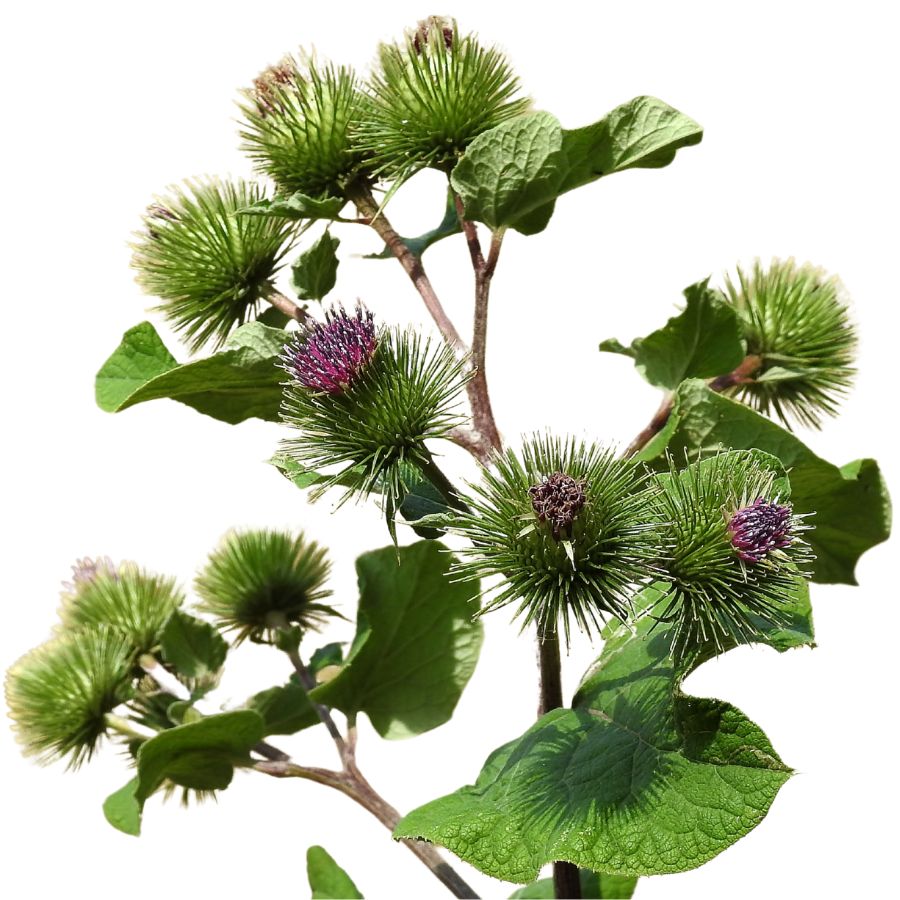
Burdock, also known as burrweed or beggar’s buttons, grows large, floppy leaves and produces clusters of sticky seed heads that cling to clothing and fur. The plant can easily tower over you once it matures, especially when the thick stalks shoot up.
The root is the main edible part and has a crisp texture with a mild, sweet, slightly earthy flavor when cooked. You should avoid eating the leaves or seed heads, as they tend to be unpleasantly bitter and tough even when young.
When you cook burdock root, it works well sliced thin and stir-fried, boiled into soups, or simmered with other vegetables to soak up savory flavors. Peeling the root before cooking can help soften the flavor and improve the texture.
It is important to watch out for lookalikes like foxglove and woolly mullein, which can grow similarly large leaves at the base. True burdock leaves have a whitish, fuzzy underside and strong, fibrous stems that are solid rather than hollow.
Toxic Plants That Look Like Edible Plants
There are plenty of wild edibles to choose from, but some toxic native plants closely resemble them. Mistaking the wrong one can lead to severe illness or even death, so it’s important to know exactly what you’re picking.
Poison Hemlock (Conium maculatum)
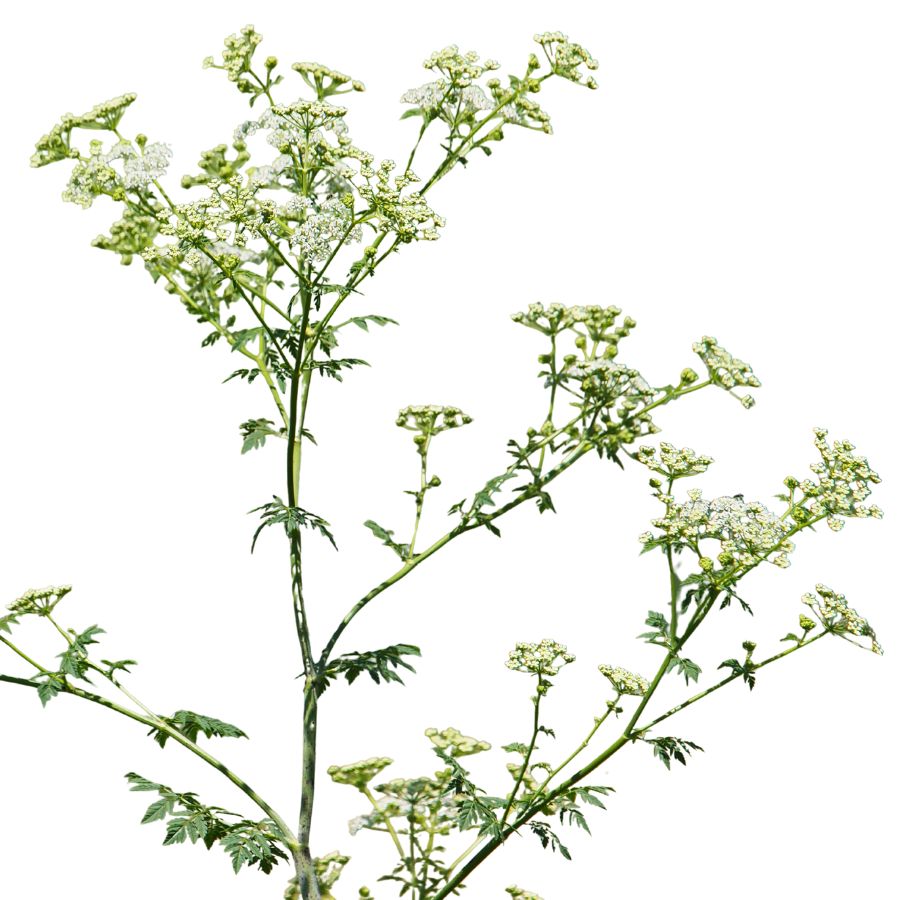
Often mistaken for: Wild carrot (Daucus carota)
Poison hemlock is a tall plant with lacy leaves and umbrella-like clusters of tiny white flowers. It has smooth, hollow stems with purple blotches and grows in sunny places like roadsides, meadows, and stream banks.
Unlike wild carrot, which has hairy stems and a dark central floret, poison hemlock has a musty odor and no flower center spot. It’s extremely toxic; just a small amount can be fatal, and even touching the sap can irritate the skin.
Water Hemlock (Cicuta spp.)
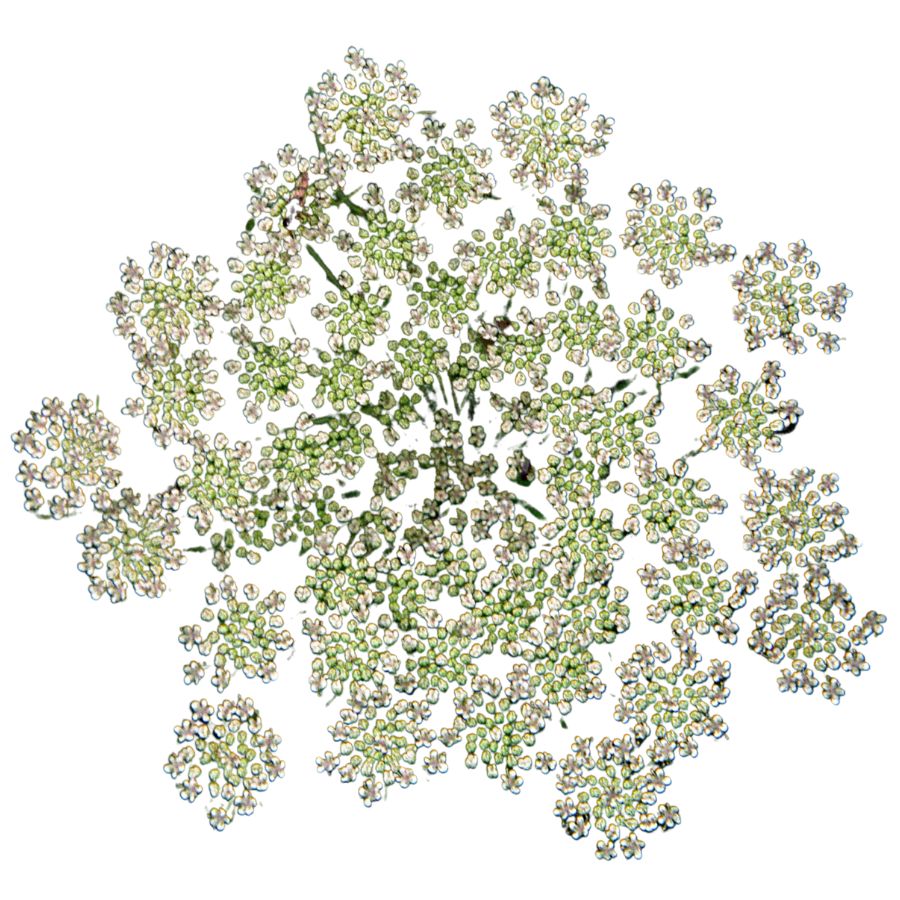
Often mistaken for: Wild parsnip (Pastinaca sativa) or wild celery (Apium spp.)
Water hemlock is a tall, branching plant with umbrella-shaped clusters of small white flowers. It grows in wet places like stream banks, marshes, and ditches, with stems that often show purple streaks or spots.
It can be confused with wild parsnip or wild celery, but its thick, hollow roots have internal chambers and release a yellow, foul-smelling sap when cut. Water hemlock is the most toxic plant in North America, and just a small amount can cause seizures, respiratory failure, and death.
False Hellebore (Veratrum viride)
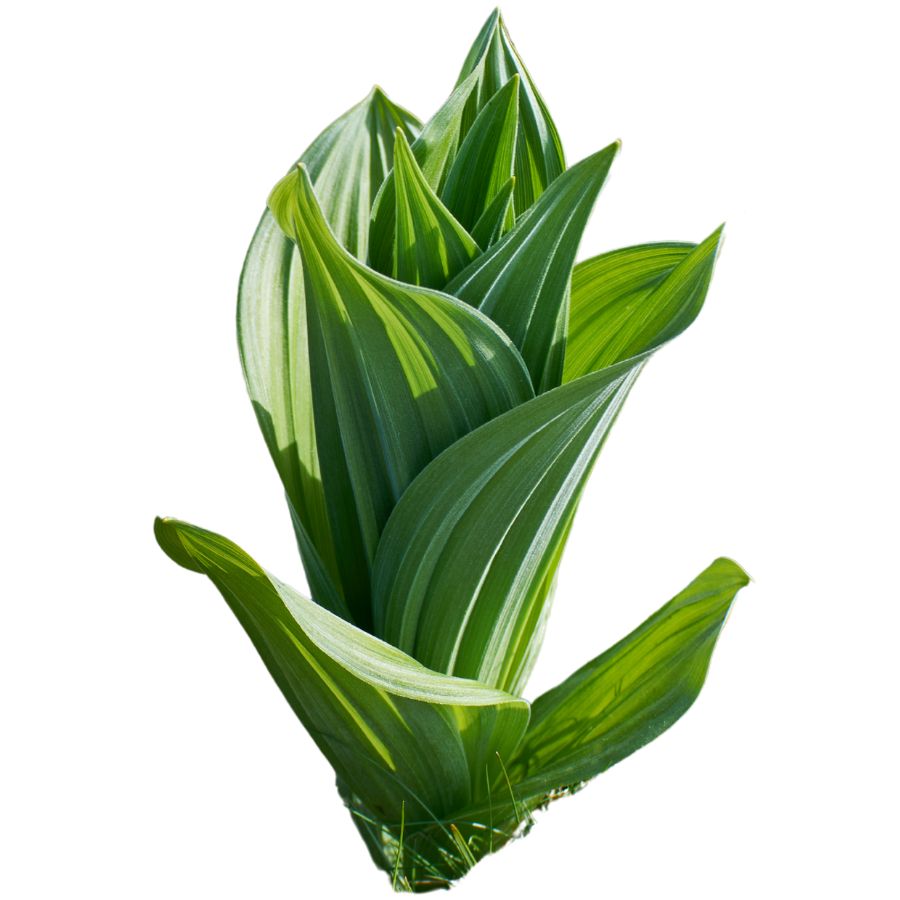
Often mistaken for: Ramps (Allium tricoccum)
False hellebore is a tall plant with broad, pleated green leaves that grow in a spiral from the base, often appearing early in spring. It grows in moist woods, meadows, and along streams.
It’s commonly mistaken for ramps, but ramps have a strong onion or garlic smell, while false hellebore is odorless and later grows a tall flower stalk. The plant is highly toxic, and eating any part can cause nausea, a slowed heart rate, and even death due to its alkaloids that affect the nervous and cardiovascular systems.
Death Camas (Zigadenus spp.)
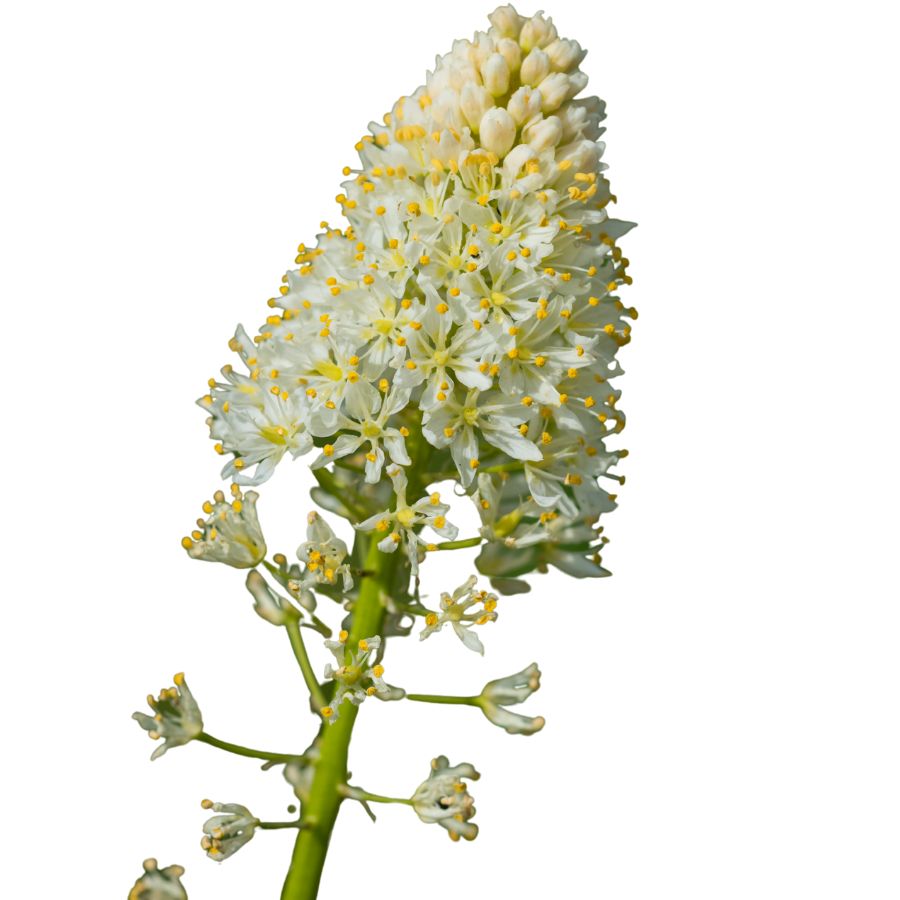
Often mistaken for: Wild onion or wild garlic (Allium spp.)
Death camas is a slender, grass-like plant that grows from underground bulbs and is found in open woods, meadows, and grassy hillsides. It has small, cream-colored flowers in loose clusters atop a tall stalk.
It’s often confused with wild onion or wild garlic due to their similar narrow leaves and habitats, but only Allium plants have a strong onion or garlic scent, while death camas has none. The plant is extremely poisonous, especially the bulbs, and even a small amount can cause nausea, vomiting, a slowed heartbeat, and potentially fatal respiratory failure.
Buckthorn Berries (Rhamnus spp.)
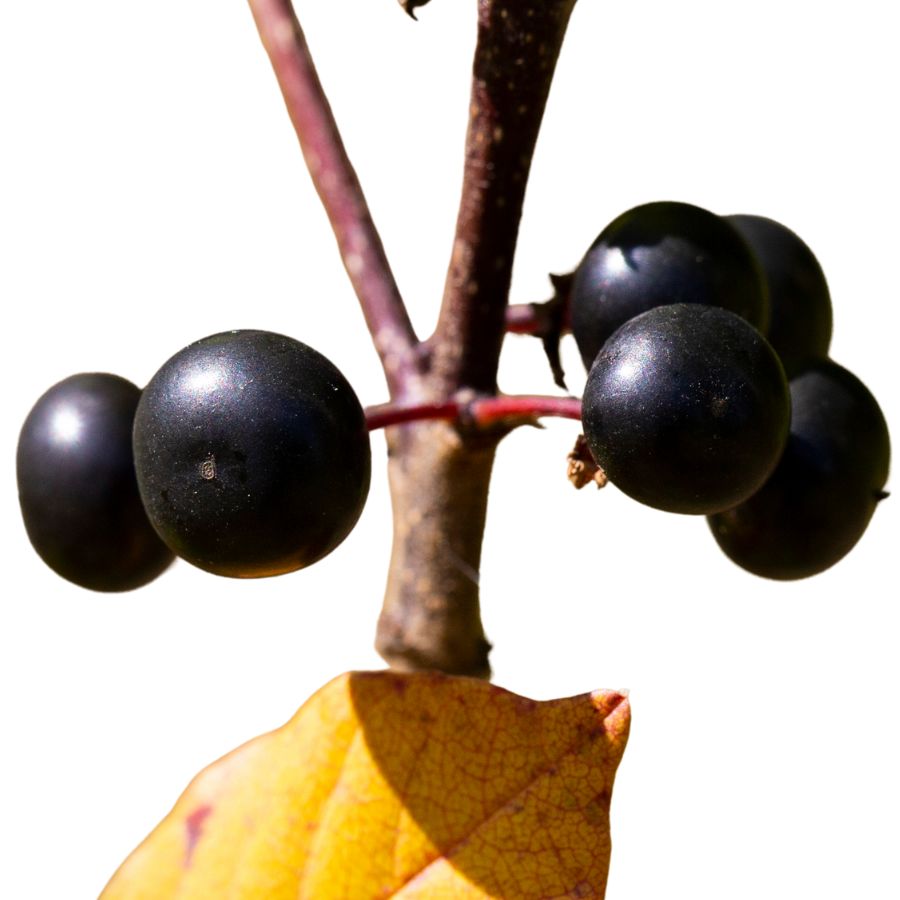
Often mistaken for: Elderberries (Sambucus spp.)
Buckthorn is a shrub or small tree often found along woodland edges, roadsides, and disturbed areas. It produces small, round berries that ripen to dark purple or black and usually grow in loose clusters.
These berries are sometimes mistaken for elderberries and other wild fruits, which also grow in dark clusters, but elderberries form flat-topped clusters on reddish stems while buckthorn berries are more scattered. Buckthorn berries are unsafe to eat as they contain compounds that can cause cramping, vomiting, and diarrhea, and large amounts may lead to dehydration and serious digestive problems.
Mayapple (Podophyllum peltatum)
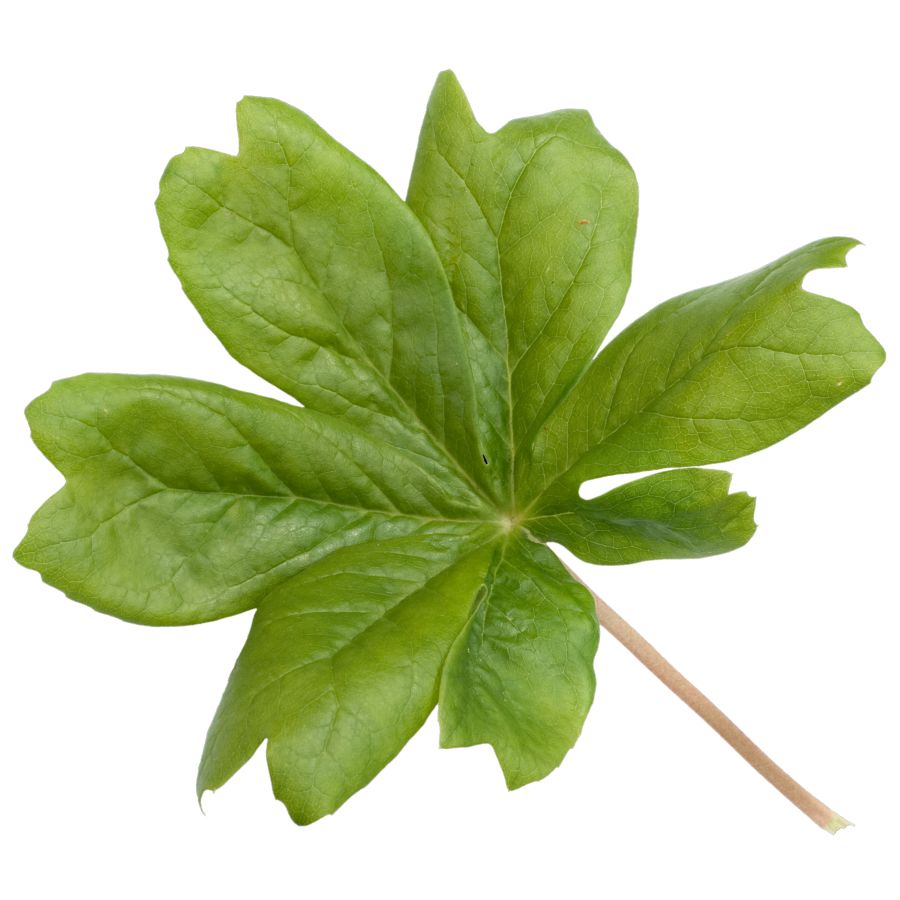
Often mistaken for: Wild grapes (Vitis spp.)
Mayapple is a low-growing plant found in shady forests and woodland clearings. It has large, umbrella-like leaves and produces a single pale fruit hidden beneath the foliage.
The unripe fruit resembles a small green grape, causing confusion with wild grapes, which grow in woody clusters on vines. All parts of the mayapple are toxic except the fully ripe, yellow fruit, which is only safe in small amounts. Eating unripe fruit or other parts can lead to nausea, vomiting, and severe dehydration.
Virginia Creeper (Parthenocissus quinquefolia)
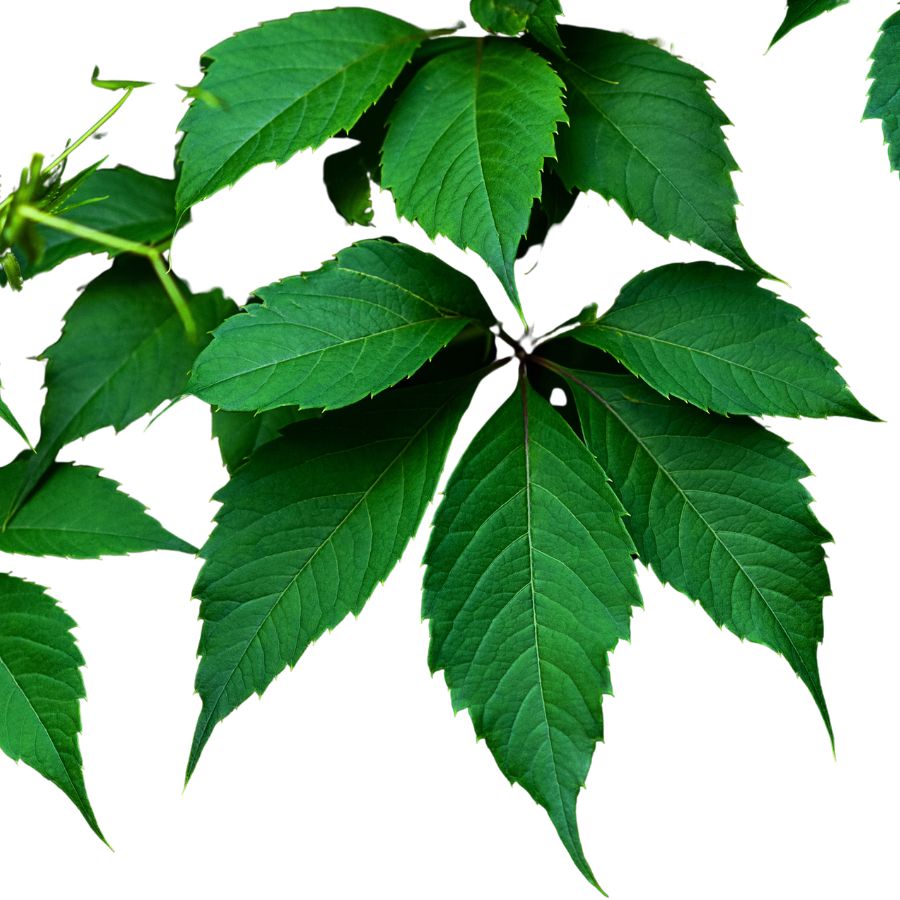
Often mistaken for: Wild grapes (Vitis spp.)
Virginia creeper is a fast-growing vine found on fences, trees, and forest edges. It has five leaflets per stem and produces small, bluish-purple berries from late summer to fall.
It’s often confused with wild grapes since both are climbing vines with similar berries, but grapevines have large, lobed single leaves and tighter fruit clusters. Virginia creeper’s berries are toxic to humans and contain oxalate crystals that can cause nausea, vomiting, and throat irritation.
Castor Bean (Ricinus communis)
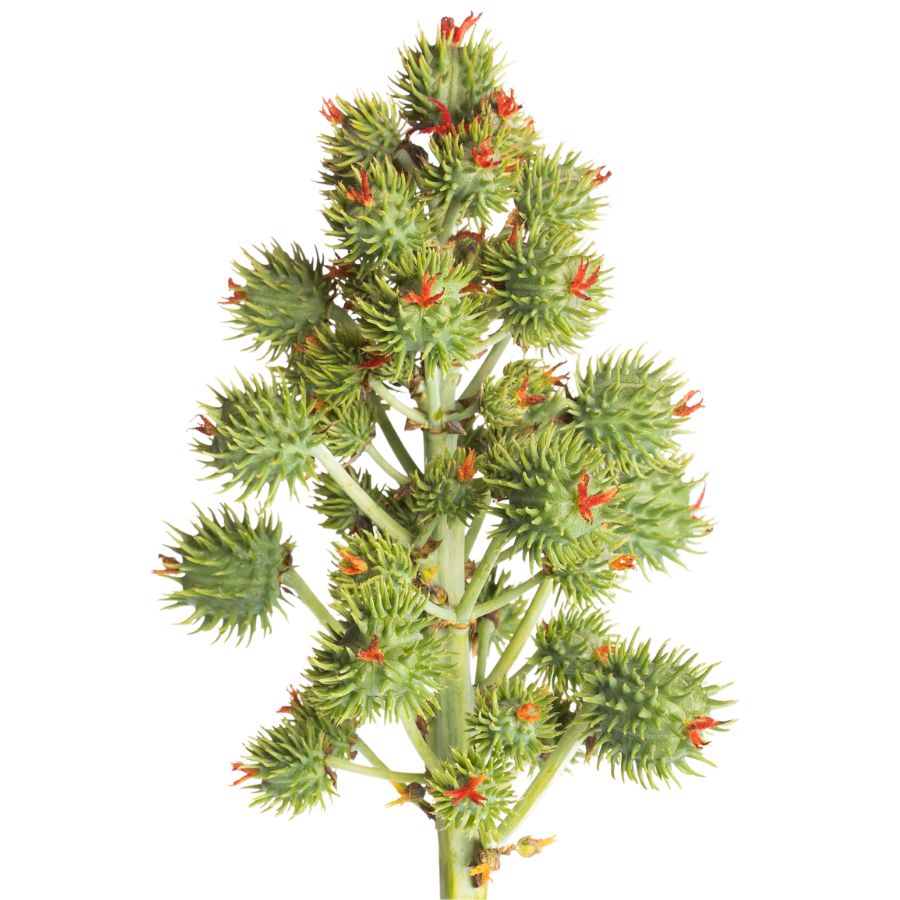
Often mistaken for: Wild rhubarb (Rumex spp. or Rheum spp.)
Castor bean is a bold plant with large, lobed leaves and tall red or green stalks, often found in gardens, along roadsides, and in disturbed areas in warmer regions in the US. Its red-tinged stems and overall size can resemble wild rhubarb to the untrained eye.
Unlike rhubarb, castor bean plants produce spiny seed pods containing glossy, mottled seeds that are extremely toxic. These seeds contain ricin, a deadly compound even in small amounts. While all parts of the plant are toxic, the seeds are especially dangerous and should never be handled or ingested.
A Quick Reminder
Before we get into the specifics about where and how to find these mushrooms, we want to be clear that before ingesting any wild mushroom, it should be identified with 100% certainty as edible by someone qualified and experienced in mushroom identification, such as a professional mycologist or an expert forager. Misidentification of mushrooms can lead to serious illness or death.
All mushrooms have the potential to cause severe adverse reactions in certain individuals, even death. If you are consuming mushrooms, it is crucial to cook them thoroughly and properly and only eat a small portion to test for personal tolerance. Some people may have allergies or sensitivities to specific mushrooms, even if they are considered safe for others.
The information provided in this article is for general informational and educational purposes only. Foraging for wild mushrooms involves inherent risks.
How to Get the Best Results Foraging
Safety should always come first when it comes to foraging. Whether you’re in a rural forest or a suburban greenbelt, knowing how to harvest wild foods properly is a key part of staying safe and respectful in the field.
Always Confirm Plant ID Before You Harvest Anything
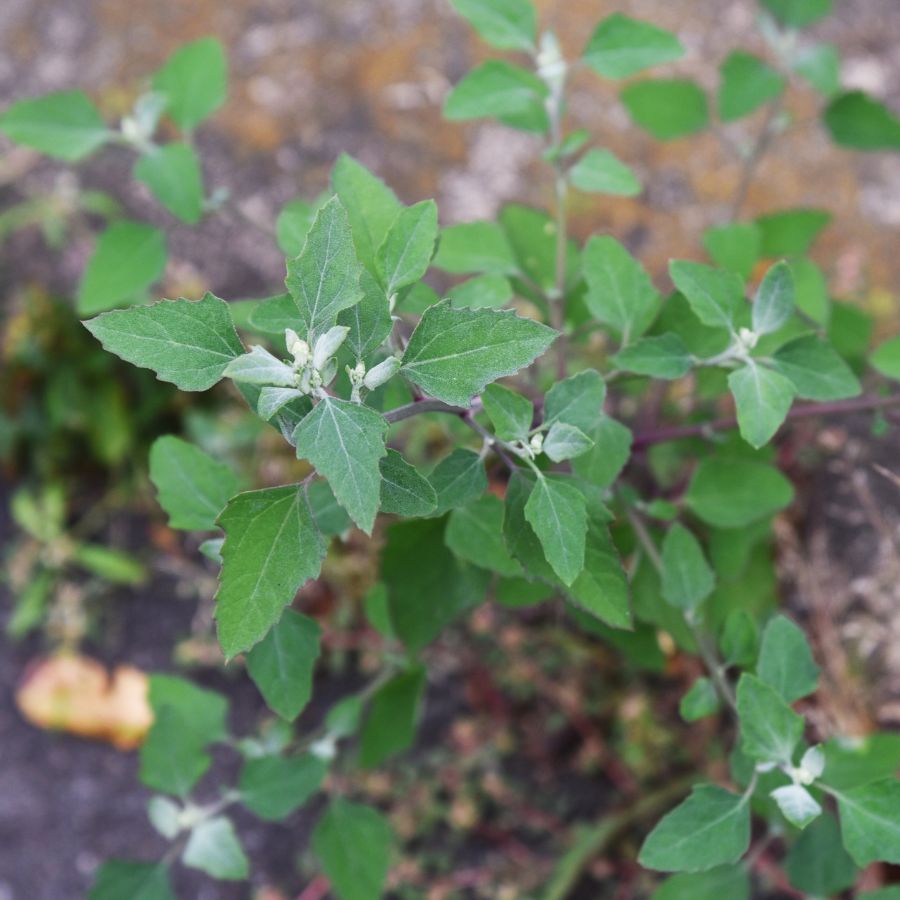
Knowing exactly what you’re picking is the most important part of safe foraging. Some edible plants have nearly identical toxic lookalikes, and a wrong guess can make you seriously sick.
Use more than one reliable source to confirm your ID, like field guides, apps, and trusted websites. Pay close attention to small details. Things like leaf shape, stem texture, and how the flowers or fruits are arranged all matter.
Not All Edible Plants Are Safe to Eat Whole
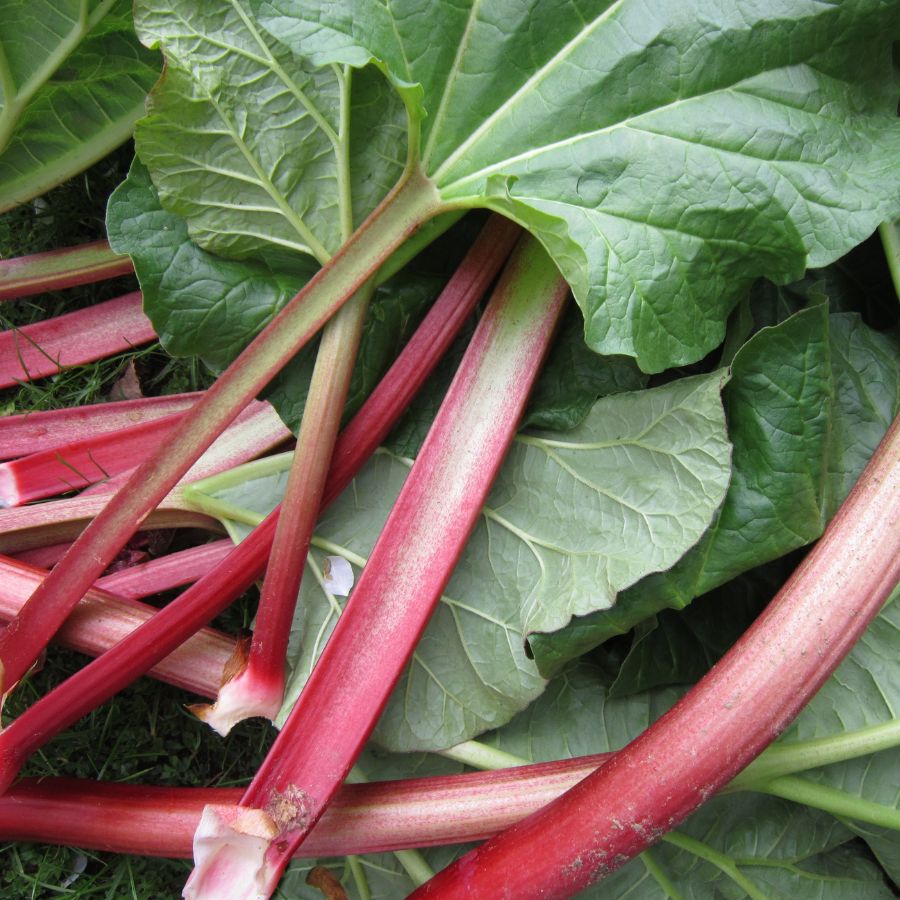
Just because a plant is edible doesn’t mean every part of it is safe. Some plants have leaves, stems, or seeds that can be toxic if eaten raw or prepared the wrong way.
For example, pokeweed is only safe when young and properly cooked, while elderberries need to be heated before eating. Rhubarb stems are fine, but the leaves are poisonous. Always look up which parts are edible and how they should be handled.
Avoid Foraging in Polluted or Contaminated Areas
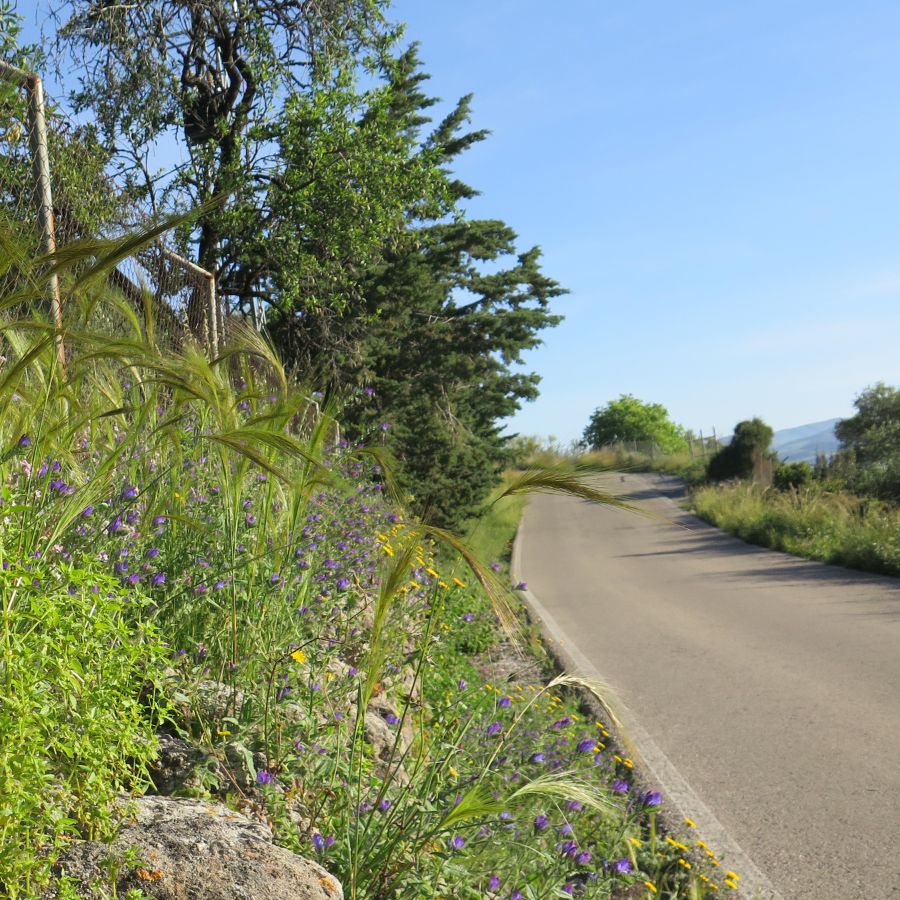
Where you forage matters just as much as what you pick. Plants growing near roads, buildings, or farmland might be coated in chemicals or growing in polluted soil.
Even safe plants can take in harmful substances from the air, water, or ground. Stick to clean, natural areas like forests, local parks that allow foraging, or your own yard when possible.
Don’t Harvest More Than What You Need
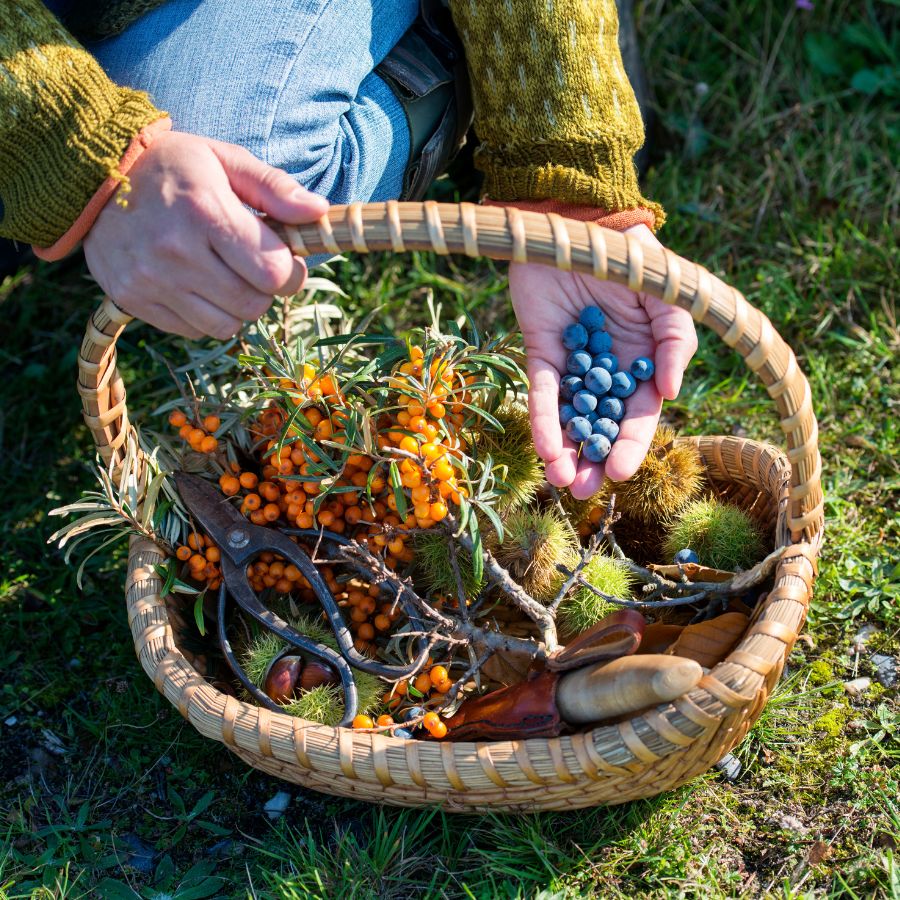
When you forage, take only what you plan to use. Overharvesting can hurt local plant populations and reduce future growth in that area.
Leaving plenty behind helps plants reproduce and supports wildlife that depends on them. It also ensures other foragers have a chance to enjoy the same resources.
Protect Yourself and Your Finds with Proper Foraging Gear

Having the right tools makes foraging easier and safer. Gloves protect your hands from irritants like stinging nettle, and a good knife or scissors lets you harvest cleanly without damaging the plant.
Use a basket or breathable bag to carry what you collect. Plastic bags hold too much moisture and can cause your greens to spoil before you get home.
This forager’s toolkit covers the essentials for any level of experience.
Watch for Allergic Reactions When Trying New Wild Foods

Even if a wild plant is safe to eat, your body might react to it in unexpected ways. It’s best to try a small amount first and wait to see how you feel.
Be extra careful with kids or anyone who has allergies. A plant that’s harmless for one person could cause a reaction in someone else.
Check Local Rules Before Foraging on Any Land
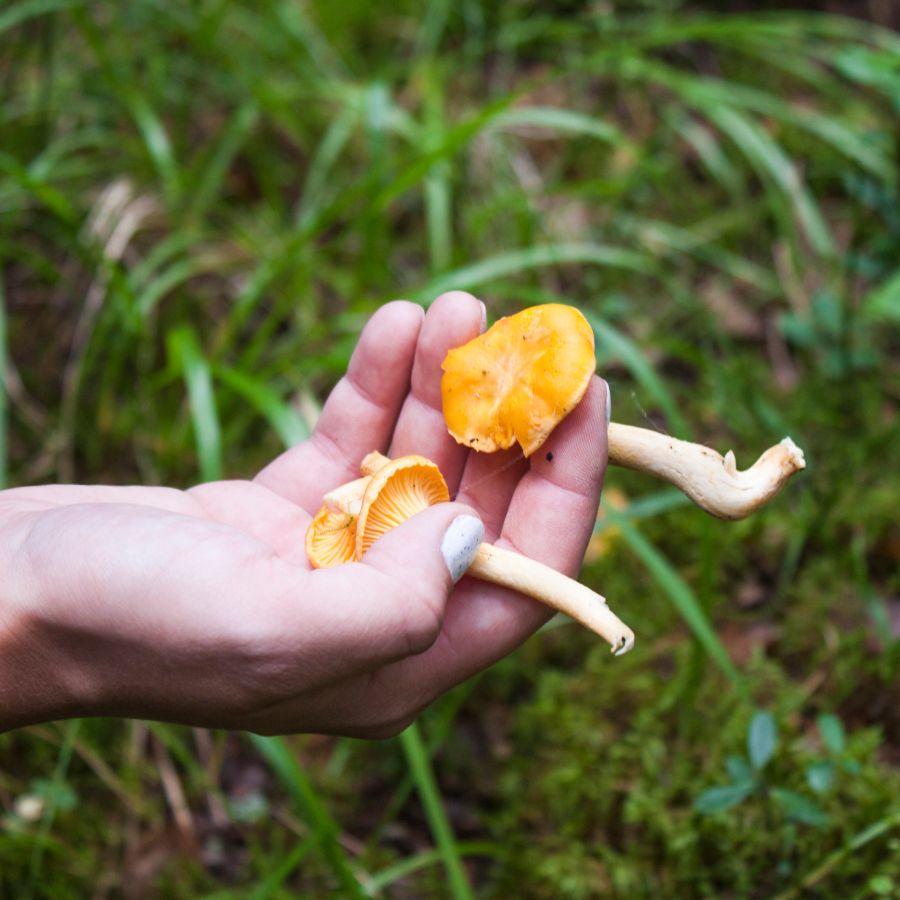
Before you start foraging, make sure you know the rules for the area you’re in. What’s allowed in one spot might be completely off-limits just a few miles away.
Some public lands permit limited foraging, while others, like national parks, usually don’t allow it at all. If you’re on private property, always get permission first.
Before you head out
Before embarking on any foraging activities, it is essential to understand and follow local laws and guidelines. Always confirm that you have permission to access any land and obtain permission from landowners if you are foraging on private property. Trespassing or foraging without permission is illegal and disrespectful.
For public lands, familiarize yourself with the foraging regulations, as some areas may restrict or prohibit the collection of mushrooms or other wild foods. These regulations and laws are frequently changing so always verify them before heading out to hunt. What we have listed below may be out of date and inaccurate as a result.
Where to Find Forageables in the State
There is a range of foraging spots where edible plants grow naturally and often in abundance:
| Plant | Locations |
| American Beautyberry (Callicarpa americana) | – Oak Mountain State Park – Pell City woodlands – Tuscaloosa Arboretum |
| Bramble (Rubus fruticosus) | – Redstone Arsenal (with access) – Bankhead National Forest – Cheaha State Park |
| Blueberry (Vaccinium spp.) | – UA Arboretum (viewing only) – Longleaf pine forests in Lower Coastal Plain – DeKalb and Jackson Counties |
| Bull Thistle (Cirsium vulgare) | – Chilton County roadsides – Cullman County pastures – Franklin County clearings |
| Burdock (Arctium minus) | – Butler County fields – DeKalb County roadsides – Etowah County disturbed areas |
| Chickweed (Stellaria media) | – Etowah County yards – Cullman County gardens – Tuscaloosa County lawns |
| Dandelion (Taraxacum officinale) | – Jefferson County parks – Madison County fields – Mobile County roadsides |
| Milkweed (Asclepias syriaca) | – Northeast Alabama fields – Black Belt region pastures – Tennessee Valley roadsides |
| Daylily (Hemerocallis fulva) | – Birmingham urban areas – Montgomery city parks – Huntsville residential zones |
| Curly Dock (Rumex crispus) | – Tuscaloosa County roadsides – Shelby County fields – Lee County disturbed soils |
| Elderberry (Sambucus nigra) | – Talladega National Forest – Conecuh National Forest – Bankhead National Forest |
| Goldenrod (Solidago canadensis) | – Blount County meadows – Calhoun County fields – Etowah County roadsides |
| Zarzaparrilla (Smilax bona-nox) | – Mobile-Tensaw Delta – Conecuh National Forest – Tuskegee National Forest |
| Groundnut (Apios americana) | – Tallapoosa River banks – Coosa River floodplains – Black Warrior River edges |
| Henbit (Lamium amplexicaule) | – Etowah County yards – Shelby County gardens – Madison County lawns |
| Jerusalem Artichoke (Helianthus tuberosus) | – Talladega County fields – Chilton County roadsides – Elmore County meadows |
| Lamb’s Quarters (Chenopodium album) | – Montgomery County gardens – Jefferson County vacant lots – Lee County fields |
| Maypop (Passiflora incarnata) | – Tuscaloosa County fences – Shelby County roadsides – Baldwin County fields |
| Mulberry (Morus rubra) | – Huntsville greenways – Birmingham parks – Mobile urban areas |
| Muscadine (Vitis rotundifolia) | – Conecuh National Forest – Tuskegee National Forest – Talladega National Forest |
| New Jersey Tea (Ceanothus americanus) | – Bankhead National Forest – Cheaha State Park – Oak Mountain State Park |
| Pawpaw (Asimina triloba) | – Black Belt region woodlands – Tallapoosa River valleys – Coosa River floodplains |
| American Persimmon (Diospyros virginiana) | – Tuscaloosa County forests – Jefferson County parks – Madison County woodlands |
| Pine (Pinus spp.) | – Conecuh National Forest – Talladega National Forest – Tuskegee National Forest |
| Plantain (Plantago major) | – Mobile County lawns – Montgomery County parks – Huntsville urban areas |
| Redbud (Cercis canadensis) | – Cheaha State Park – Oak Mountain State Park – Bankhead National Forest |
| Sheep Sorrel (Rumex acetosella) | – Blount County fields – Calhoun County meadows – Etowah County roadsides |
| Smartweed (Persicaria spp.) | – Mobile-Tensaw Delta – Coosa River banks – Black Warrior River edges |
| Spicebush (Lindera benzoin) | – Talladega National Forest – Bankhead National Forest – Cheaha State Park |
| Sumac (Rhus spp.) | – Shelby County roadsides – Jefferson County fields – Madison County meadows |
| Common Blue Violet (Viola sororia) | – Montgomery County lawns – Tuscaloosa County gardens – Huntsville parks |
| Watercress (Nasturtium officinale) | – Madison County streams – Jefferson County creeks – Shelby County springs |
| Wild Lettuce (Lactuca virosa) | – Birmingham urban areas – Montgomery city parks – Huntsville roadsides |
| American Plum (Prunus americana) | – Talladega National Forest – Conecuh National Forest – Tuskegee National Forest |
| Wood Sorrel (Oxalis stricta) | – Mobile County lawns – Montgomery County gardens – Huntsville urban areas |
| Yarrow (Achillea millefolium) | – Blount County fields – Calhoun County meadows – Etowah County roadsides |
Peak Foraging Seasons
Different edible plants grow at different times of year, depending on the season and weather. Timing your search makes all the difference.
Spring
Spring brings a fresh wave of wild edible plants as the ground thaws and new growth begins:
| Plant | Months | Best Weather Conditions |
| Chickweed (Stellaria media) | March – May | Cool, moist soil after rain; shady spots |
| Dandelion (Taraxacum officinale) | March – May | Mild temperatures; moist ground |
| Curly Dock (Rumex crispus) | March – May | Damp, loamy soil; cloudy or partly sunny days |
| Henbit (Lamium amplexicaule) | February – April | Cool, damp conditions; early spring bloom |
| Redbud (Cercis canadensis) | March – April | Sunny days following rain; woodland edges |
| Common Blue Violet (Viola sororia) | March – May | Shady, moist areas; after light rainfall |
| Wild Lettuce (Lactuca virosa) | April – May | Cool, overcast days with recent rain |
| Plantain (Plantago major) | April – May | Moist soil, cooler temps before heat sets in |
| Lamb’s Quarters (Chenopodium album) | April – May | Dry or sandy soil after a light rain |
| Wood Sorrel (Oxalis stricta) | March – May | Moist woodlands or yards during cool spells |
Summer
Summer is a peak season for foraging, with fruits, flowers, and greens growing in full force:
| Plant | Months | Best Weather Conditions |
| American Beautyberry (Callicarpa americana) | June – August | Hot, sunny days with occasional rain |
| Bramble (Rubus fruticosus) | June – July | Warm, dry mornings after overnight dew |
| Blueberry (Vaccinium spp.) | June – July | Warm, sunny days; dry ground for best picking |
| Bull Thistle (Cirsium vulgare) | June – August | Dry, open fields with full sun |
| Milkweed (Asclepias syriaca) | June – July | Warm, humid days; full sun exposure |
| Daylily (Hemerocallis fulva) | May – July | Hot, humid mornings; flower blooms early |
| Elderberry (Sambucus nigra) | June – July | Warm, moist lowlands; early morning harvest |
| Goldenrod (Solidago canadensis) | July – August | Sunny days after rain; roadside patches |
| Zarzaparrilla (Smilax bona-nox) | June – August | Humid woodland edges; partly sunny days |
| Groundnut (Apios americana) | July – August | Moist floodplains during peak humidity |
| Maypop (Passiflora incarnata) | June – August | Sunny days with periodic summer rain |
| Mulberry (Morus rubra) | May – June | Warm mornings; ripe fruit drops after rain |
| Muscadine (Vitis rotundifolia) | July – August | Dry heat; grapes ripen after hot spells |
| New Jersey Tea (Ceanothus americanus) | June – August | Sunny, dry scrublands; post-thunderstorm growth |
| Sumac (Rhus spp.) | July – August | Dry, warm afternoons; roadside access |
| Smartweed (Persicaria spp.) | June – August | Moist soil near creeks; humid conditions |
| Yarrow (Achillea millefolium) | May – July | Dry meadows and roadsides; full sun |
Fall
As temperatures drop, many edible plants shift underground or produce their last harvests:
| Plant | Months | Best Weather Conditions |
| Groundnut (Apios americana) | September – October | Moist soils, cooler temps after rainfall |
| Jerusalem Artichoke (Helianthus tuberosus) | September – October | Loamy riverbanks post-summer heat |
| Maypop (Passiflora incarnata) | August – September | Warm, sunny days; ripe fruit softens after rain |
| Pawpaw (Asimina triloba) | August – September | Shaded river valleys; ripe fruit falls in early morning |
| American Persimmon (Diospyros virginiana) | September – November | Dry, cool days; fruit ripens after first frost |
| Sumac (Rhus spp.) | September – October | Crisp, dry mornings; bright red drupes peak in sun |
| Spicebush (Lindera benzoin) | September – October | Damp woodland shade with fall leaf drop |
| American Plum (Prunus americana) | August – September | Sunny forest margins with recent rain |
| Milkweed (Asclepias syriaca) | September | Seed pods form in dry, early autumn days |
| Blueberry (Vaccinium spp.) | Late August (second harvest) | Cool, clear days in upland bogs |
Winter
Winter foraging is limited but still possible, with hardy plants and preserved growth holding on through the cold:
| Plant | Months | Best Weather Conditions |
| Chickweed (Stellaria media) | December – February | Mild winter spells; damp ground from rain |
| Henbit (Lamium amplexicaule) | January – February | Warm snaps during winter; shaded lawns |
| Dandelion (Taraxacum officinale) | January – February | Temperate winter days; grassy areas post-rain |
| Watercress (Nasturtium officinale) | December – February | Cold, clear days in running freshwater |
| Pine (Pinus spp.) | Year-round (needles, nuts) | Dry, cool weather best for needle foraging |
| Plantain (Plantago major) | December – February (in warm zones) | Sunny winter days after rain |
| Wood Sorrel (Oxalis stricta) | January – February | Mild, damp ground in woodland clearings |
| Sheep Sorrel (Rumex acetosella) | January – February | Frost-tolerant; open fields after rainfall |
| Yarrow (Achillea millefolium) | January – March | Survives mild winters in dry ground patches |
One Final Disclaimer
The information provided in this article is for general informational and educational purposes only. Foraging for wild plants and mushrooms involves inherent risks. Some wild plants and mushrooms are toxic and can be easily mistaken for edible varieties.
Before ingesting anything, it should be identified with 100% certainty as edible by someone qualified and experienced in mushroom and plant identification, such as a professional mycologist or an expert forager. Misidentification can lead to serious illness or death.
All mushrooms and plants have the potential to cause severe adverse reactions in certain individuals, even death. If you are consuming foraged items, it is crucial to cook them thoroughly and properly and only eat a small portion to test for personal tolerance. Some people may have allergies or sensitivities to specific mushrooms and plants, even if they are considered safe for others.
Foraged items should always be fully cooked with proper instructions to ensure they are safe to eat. Many wild mushrooms and plants contain toxins and compounds that can be harmful if ingested.

